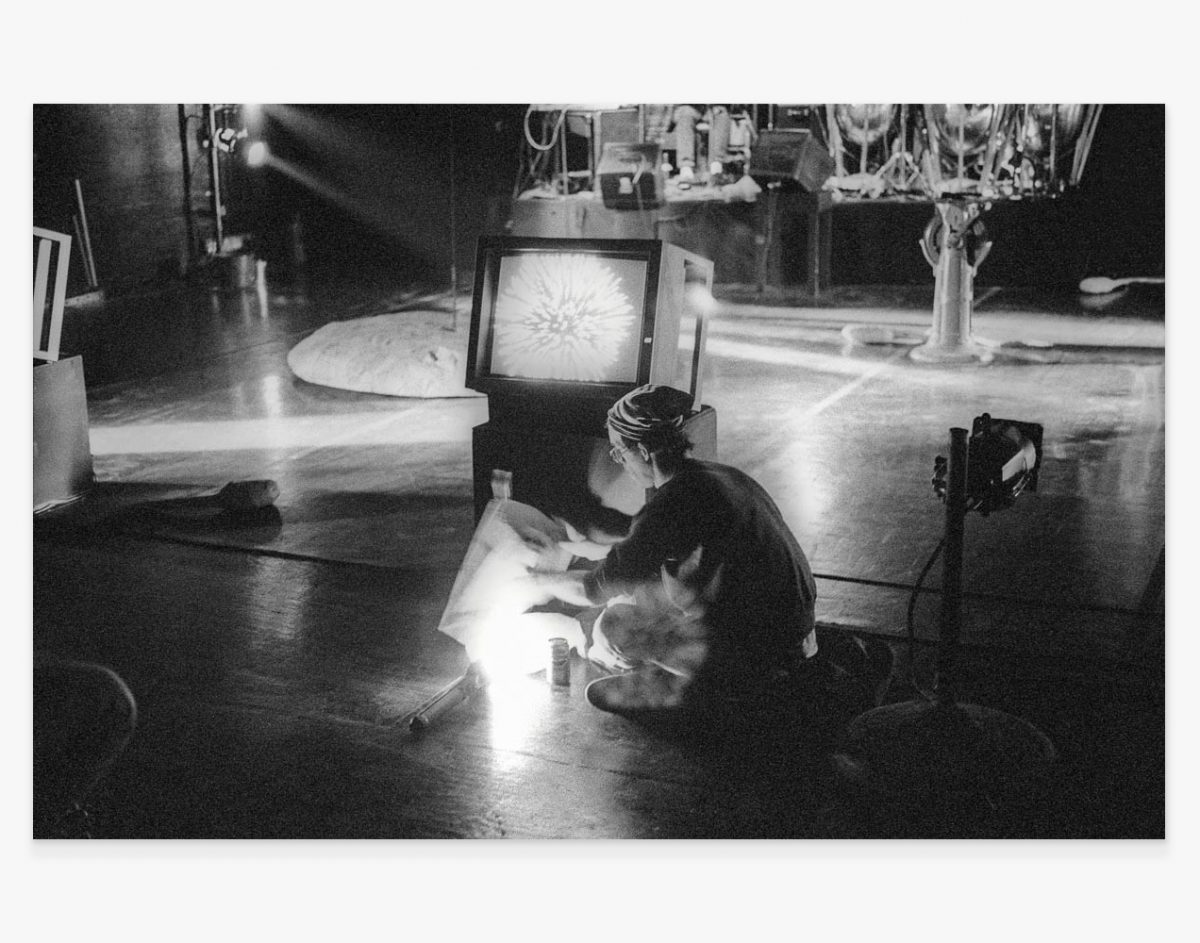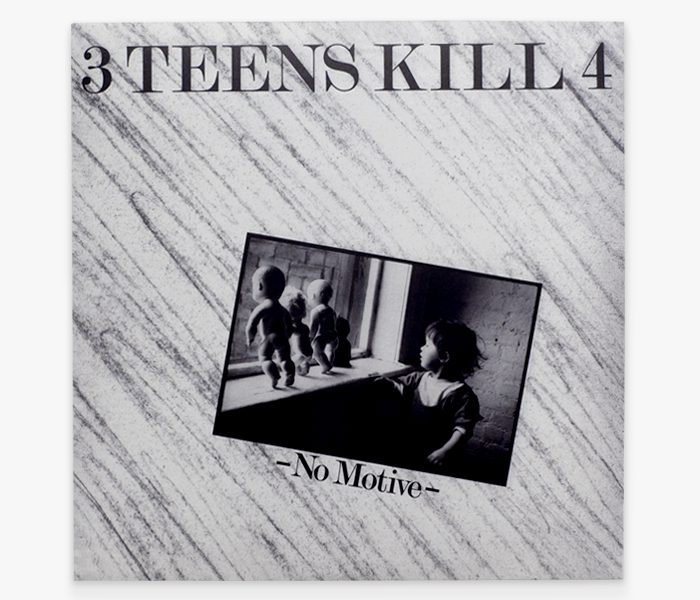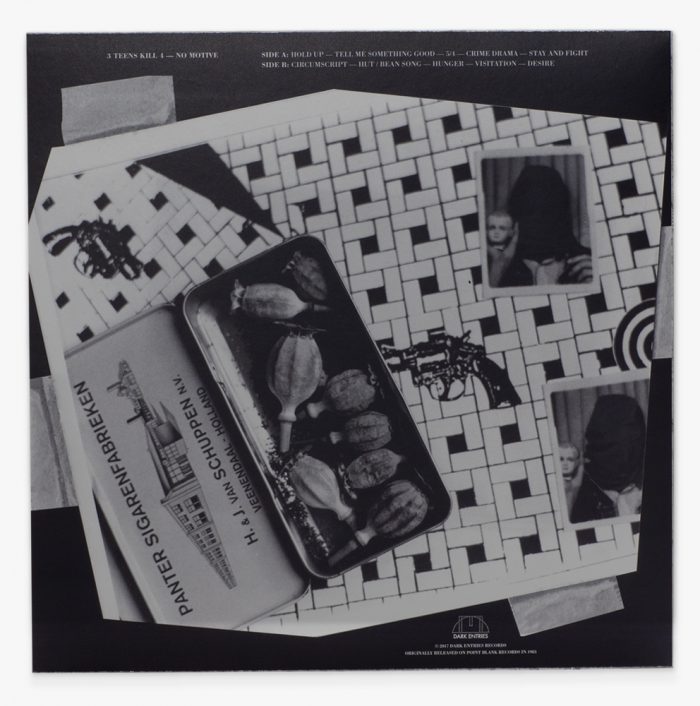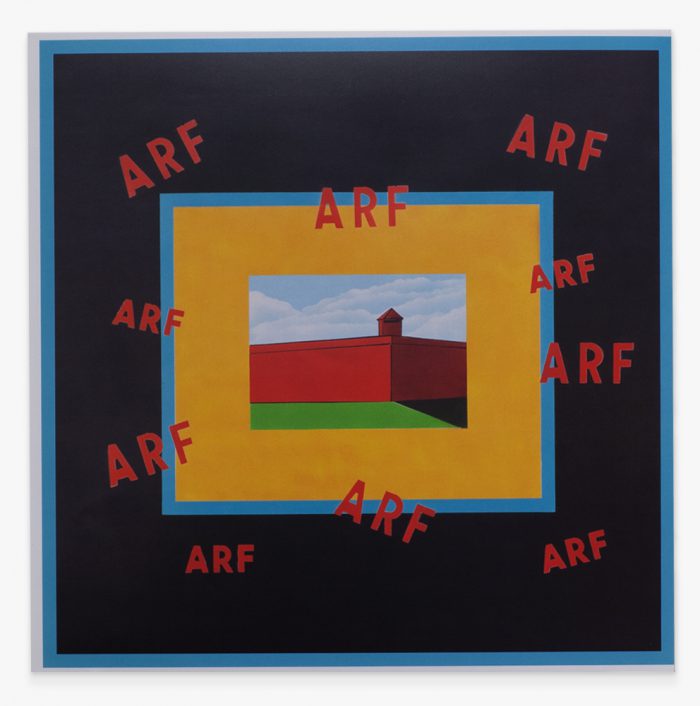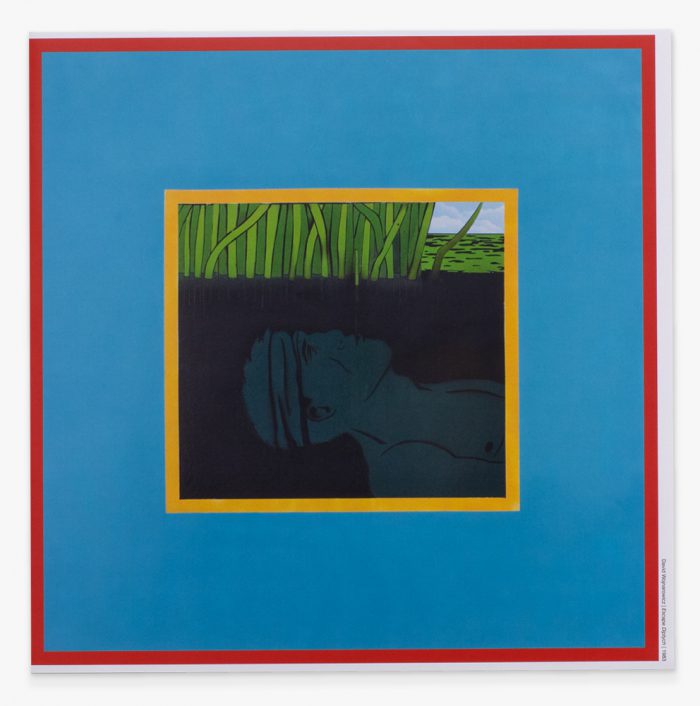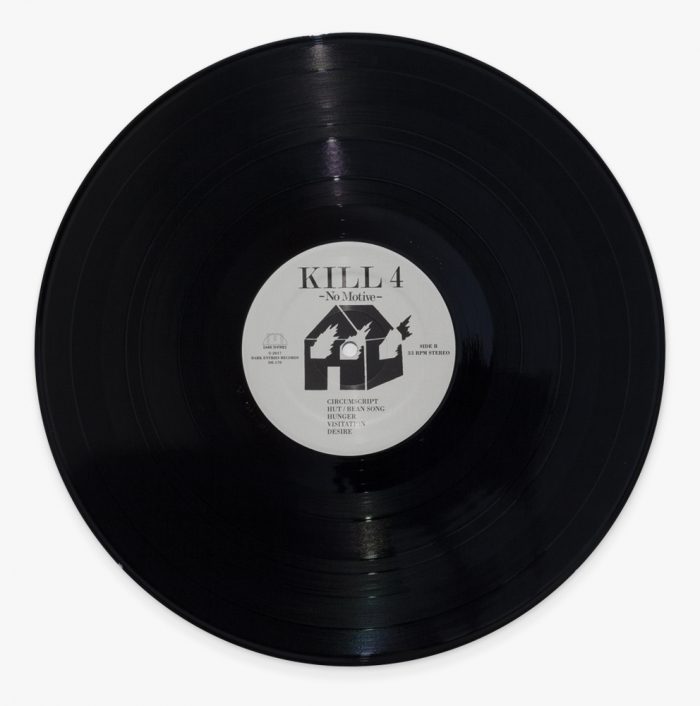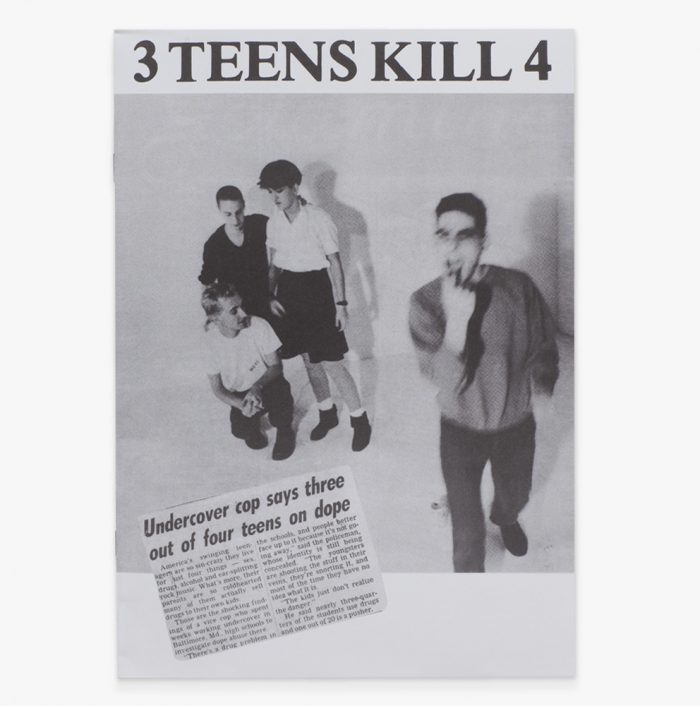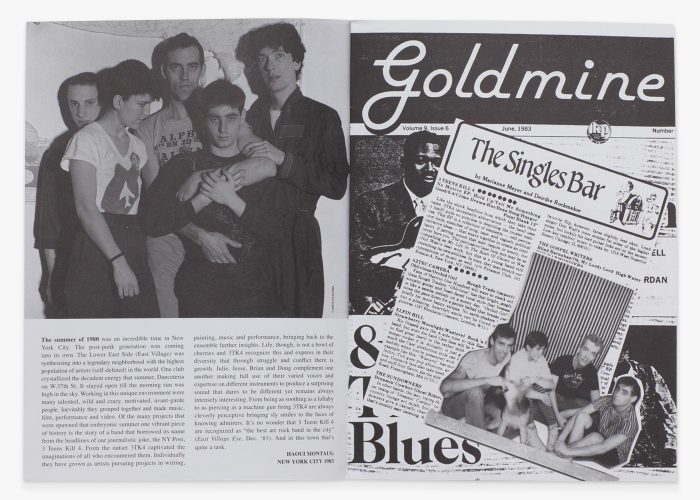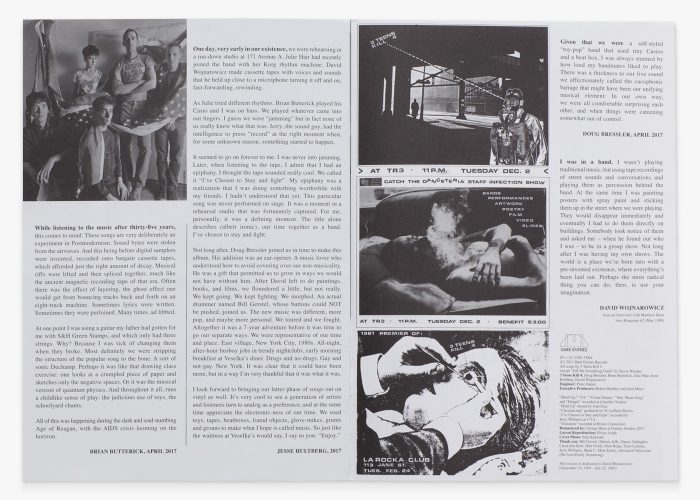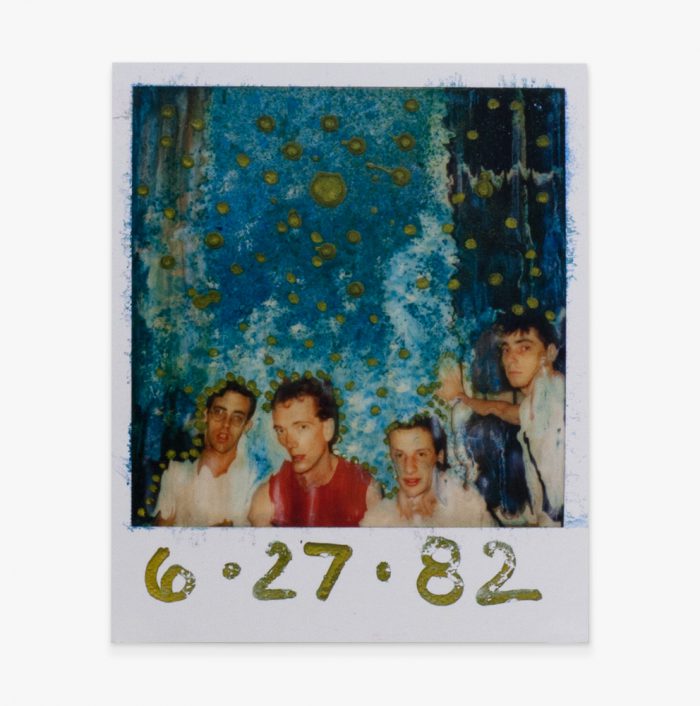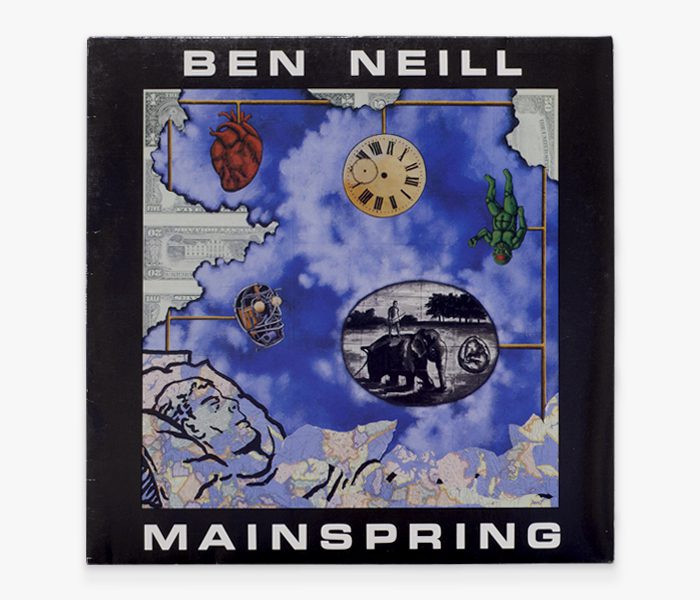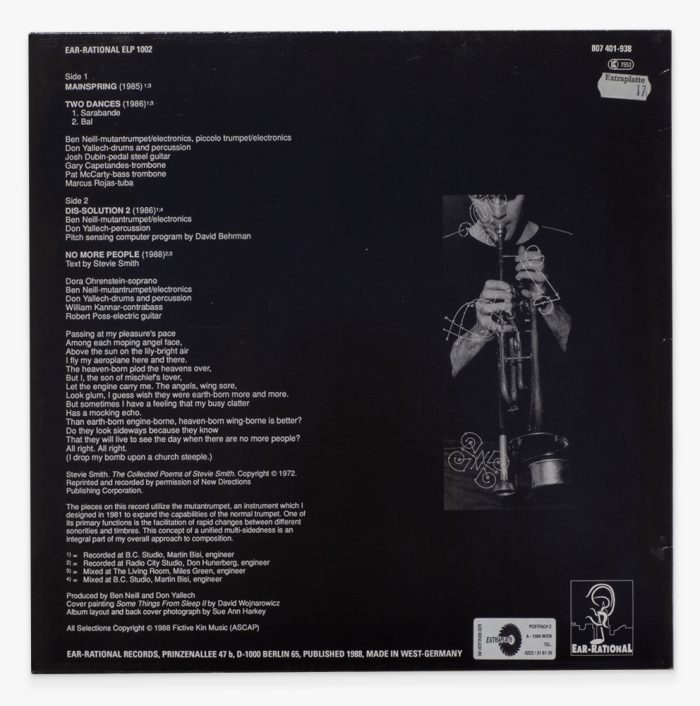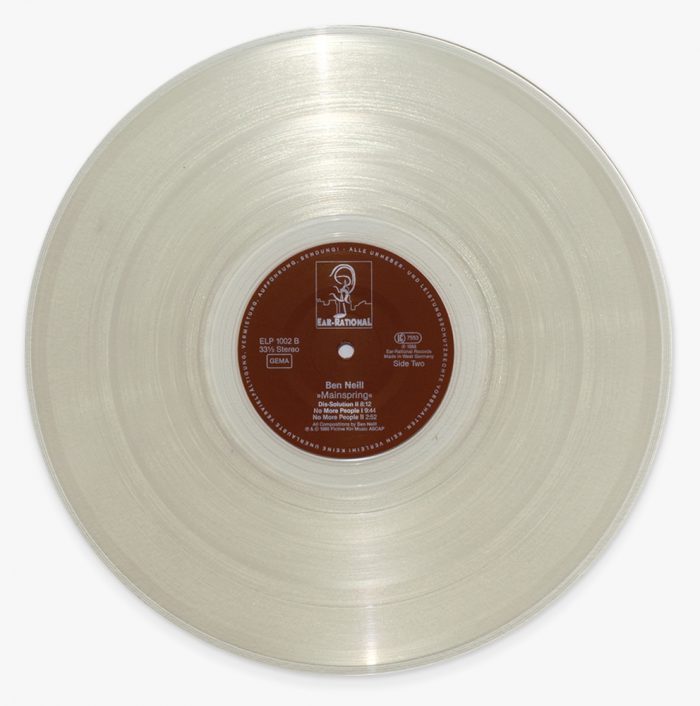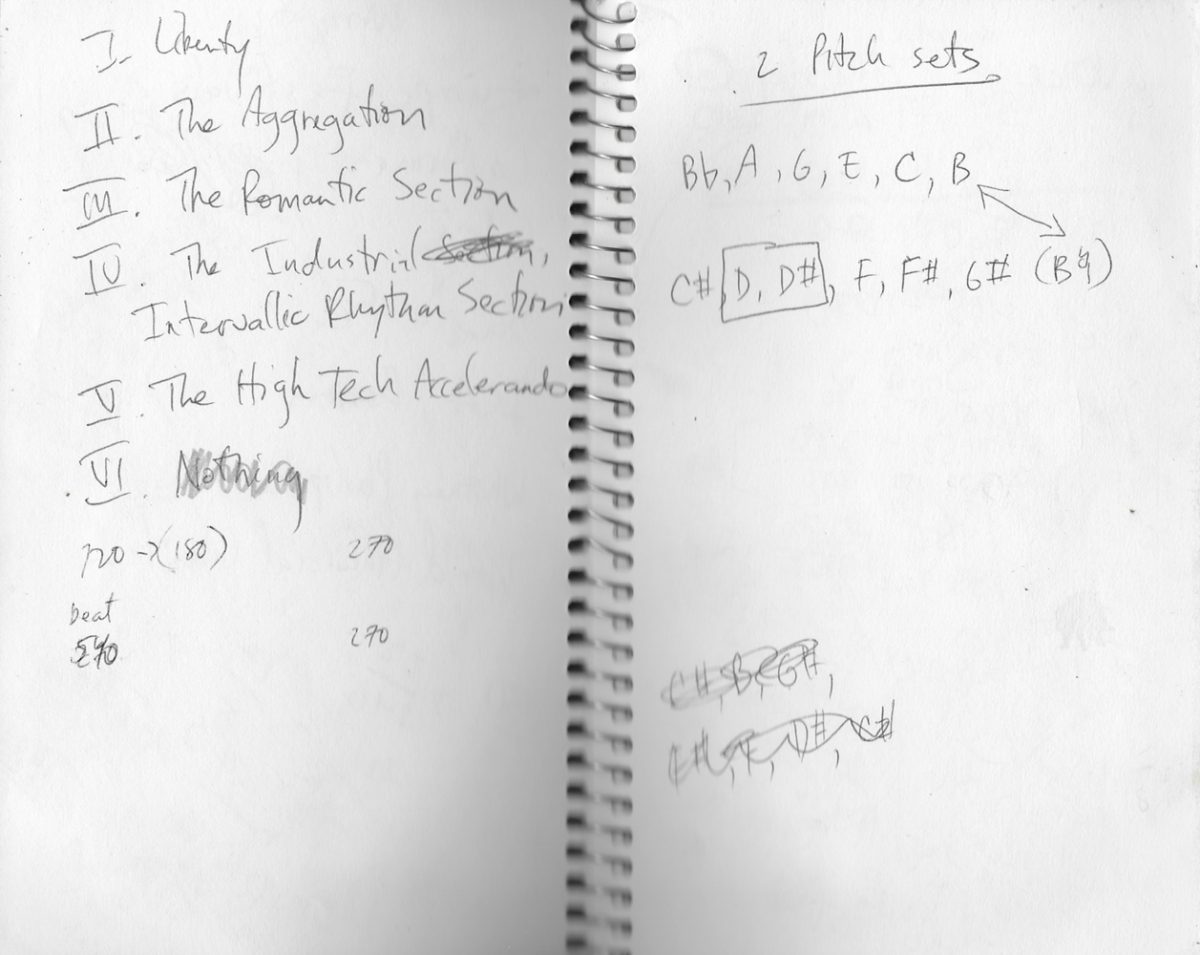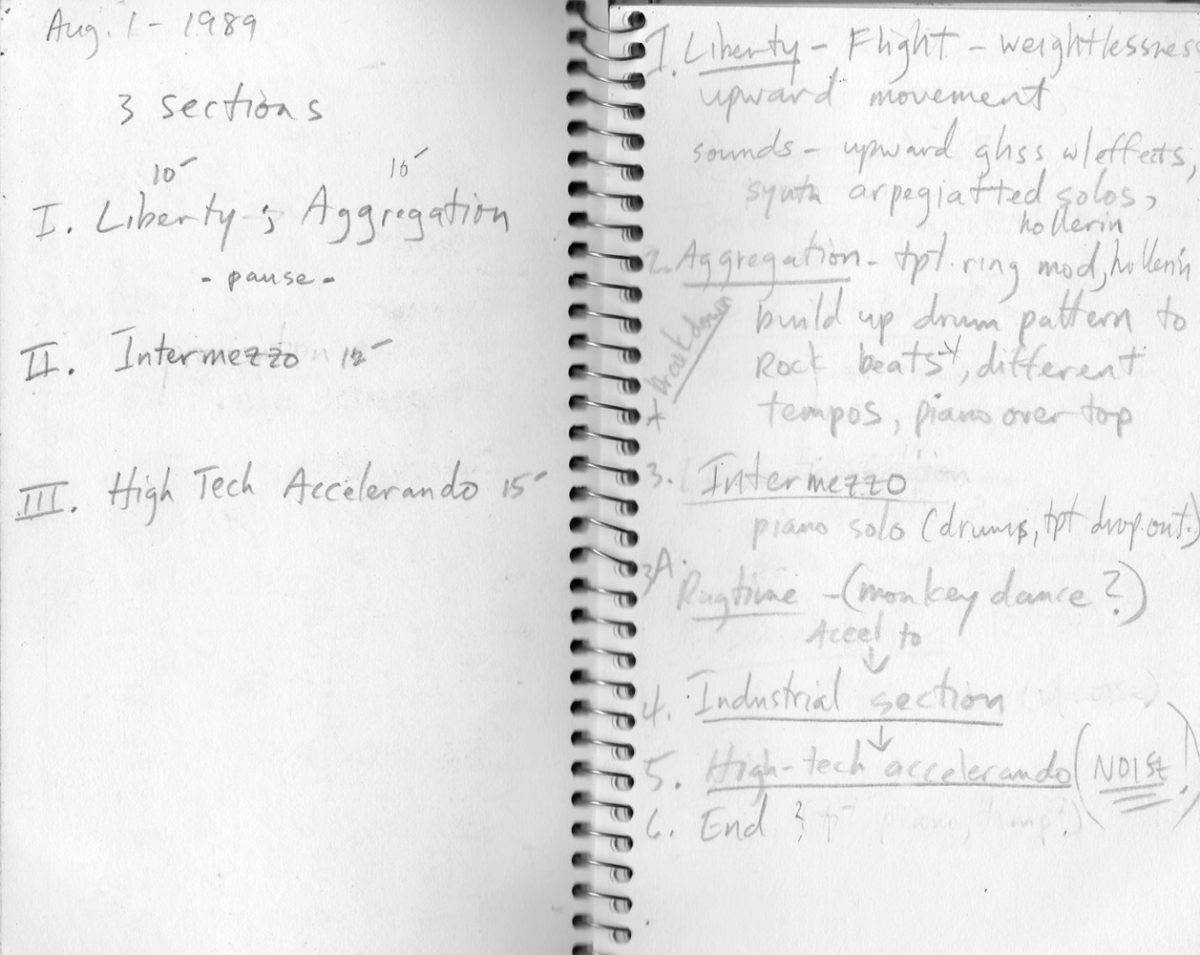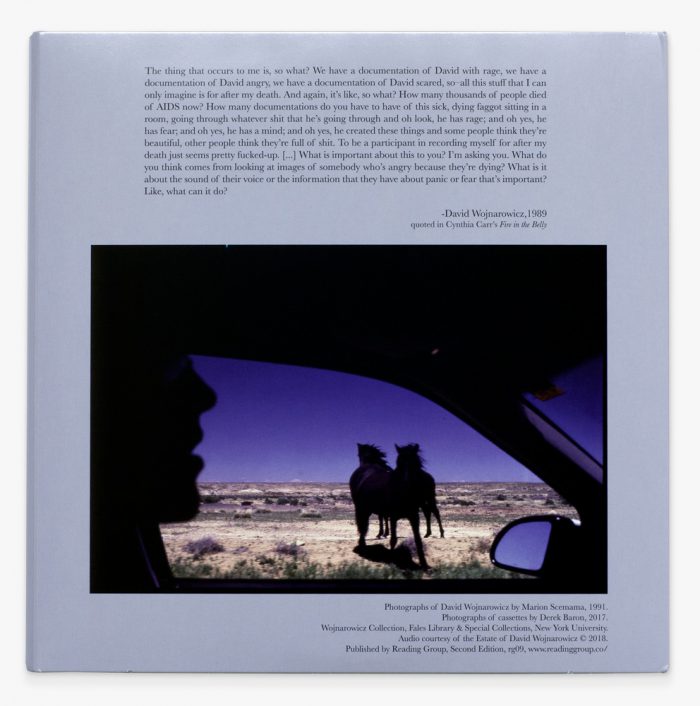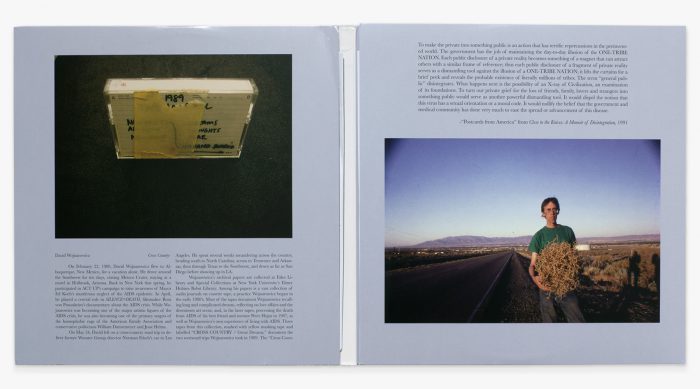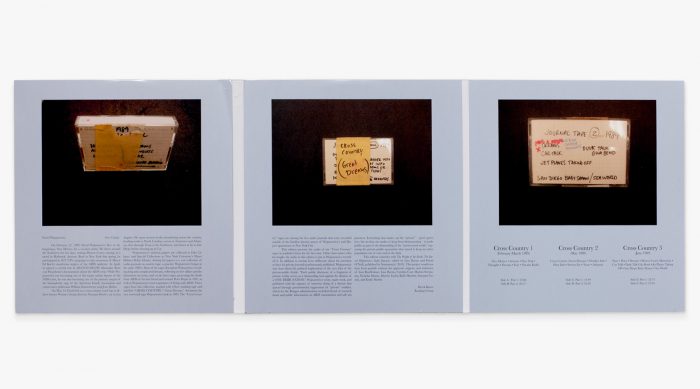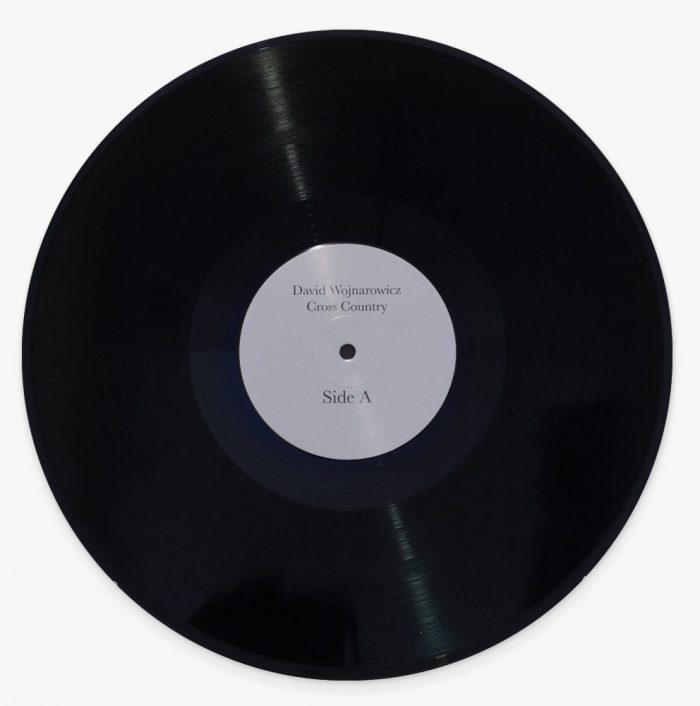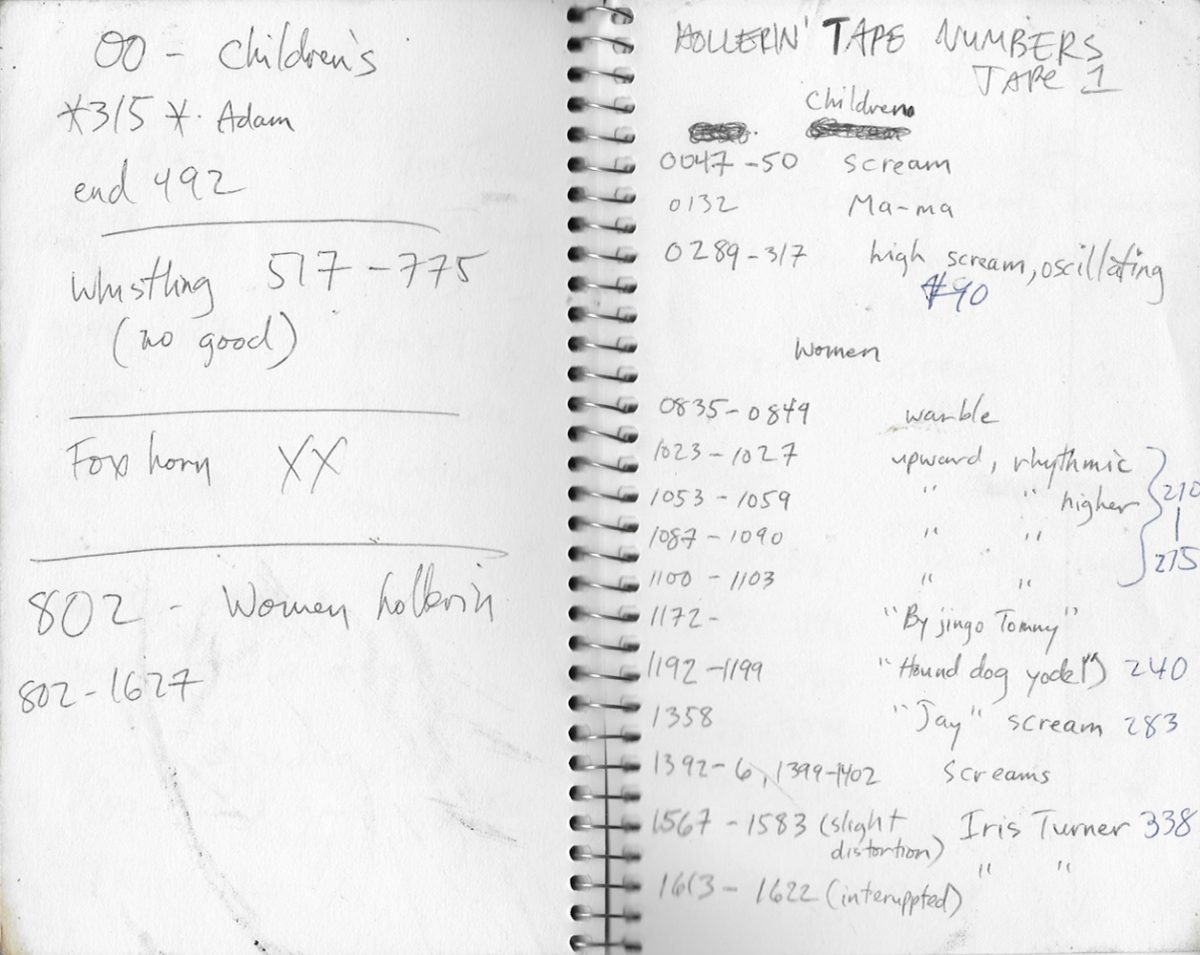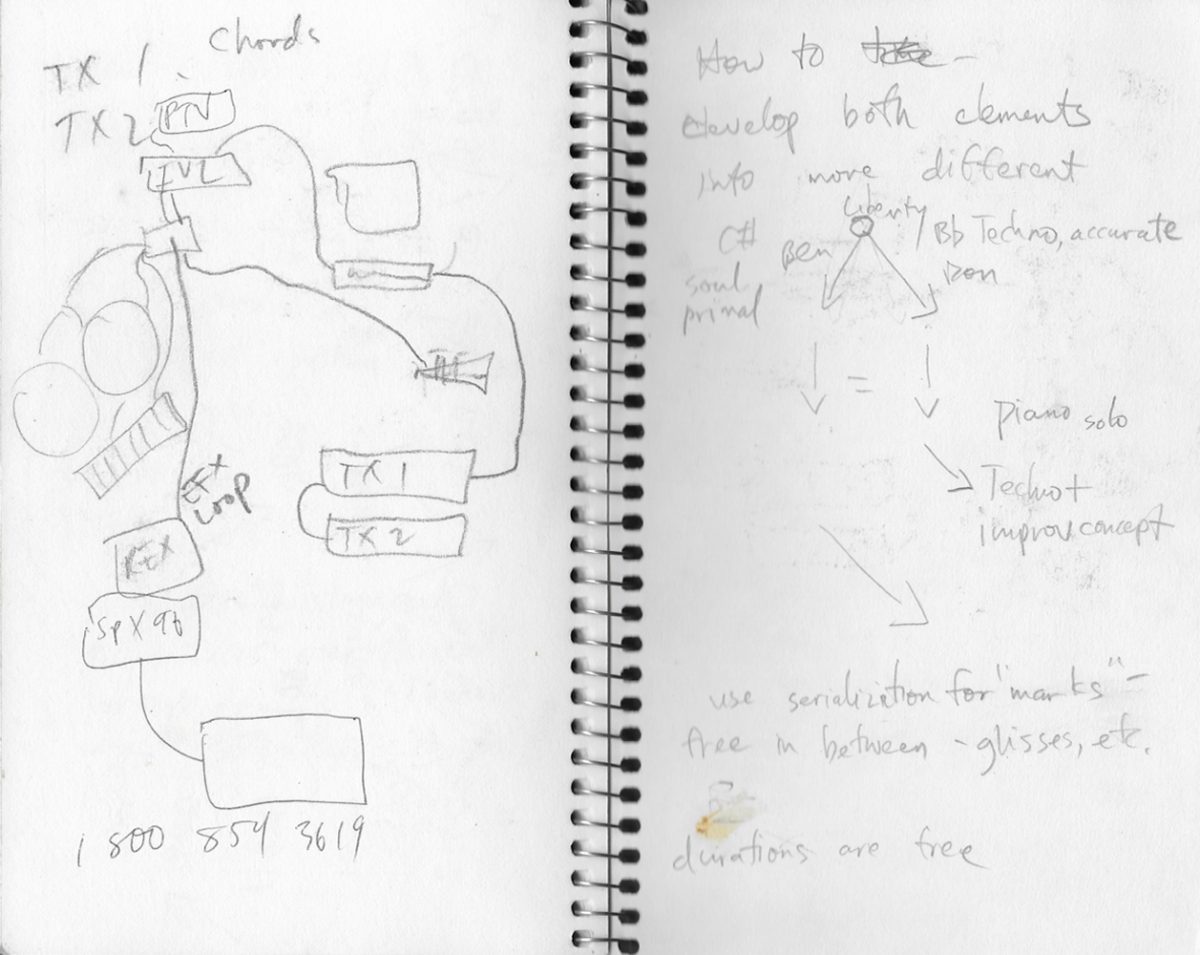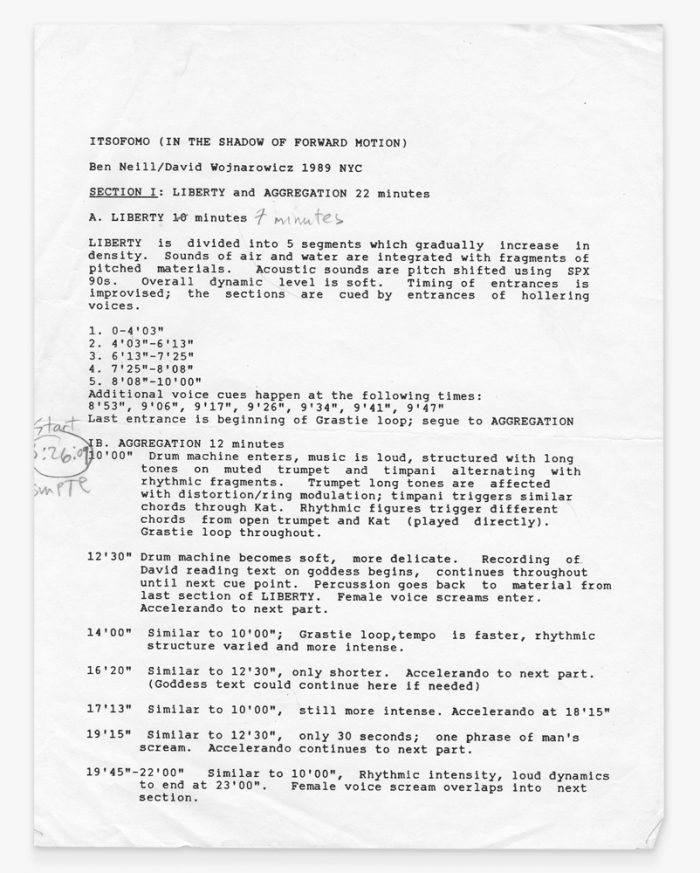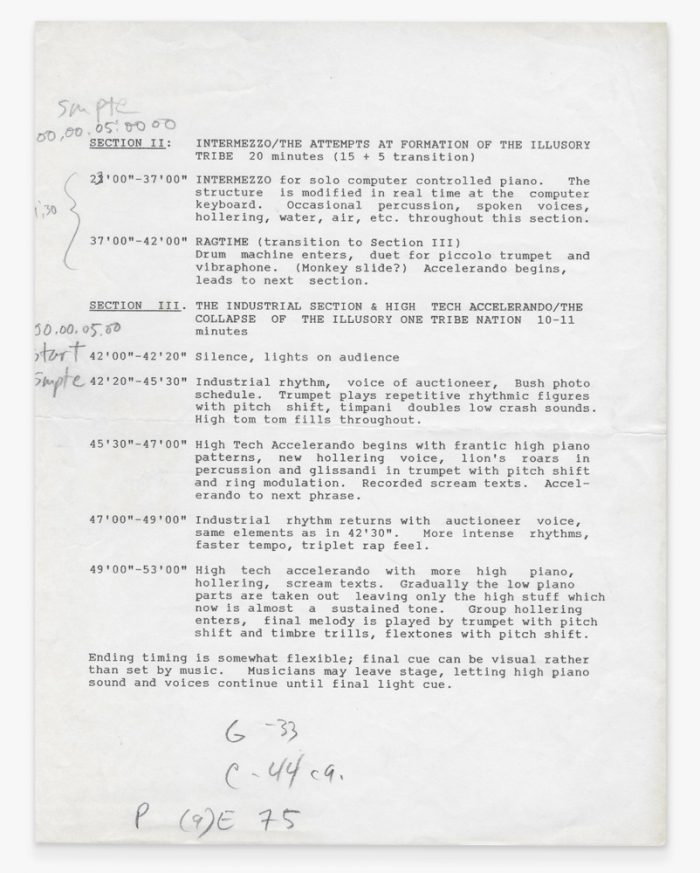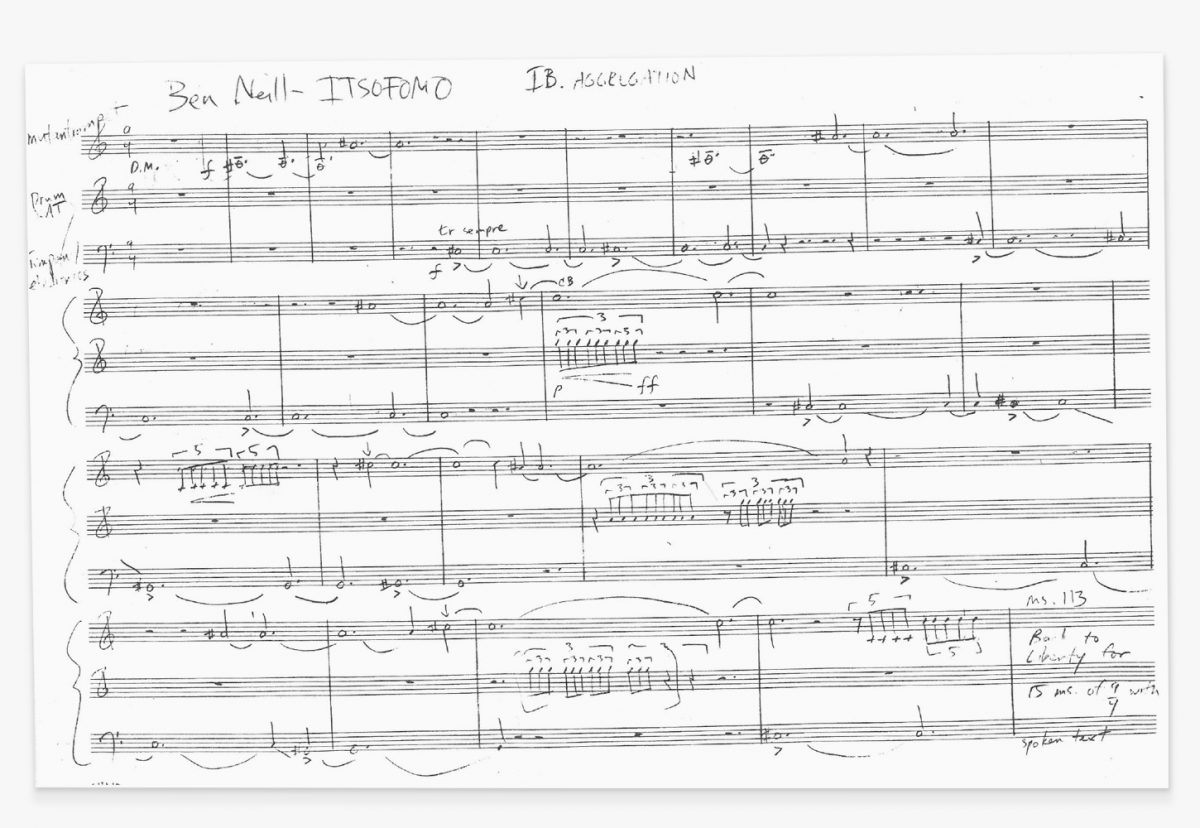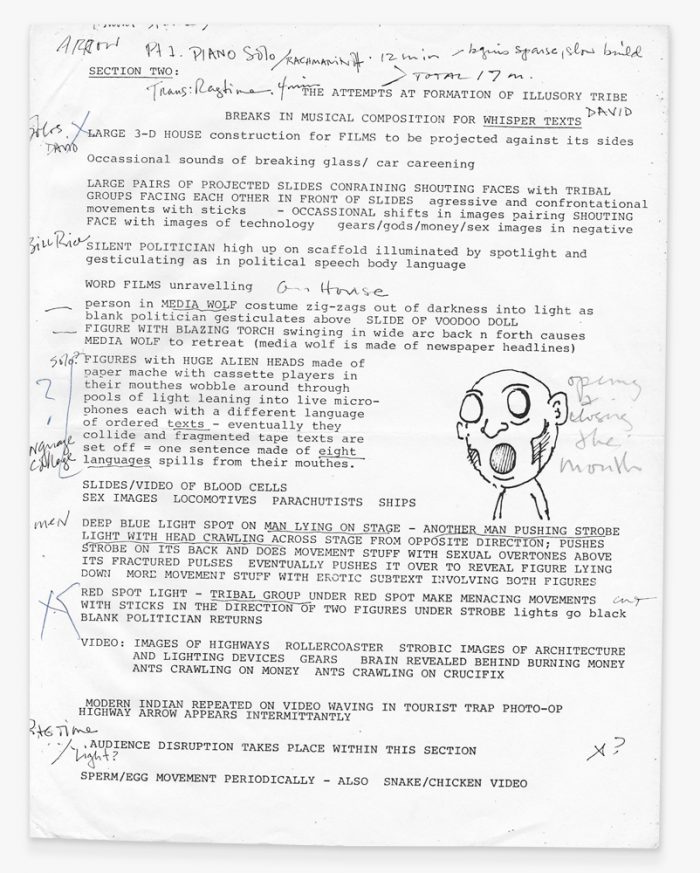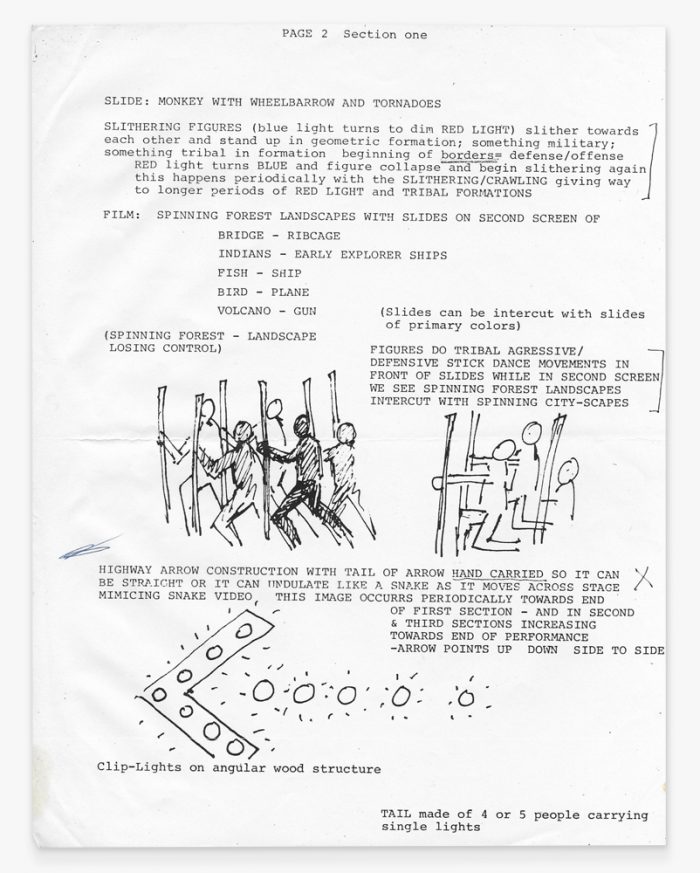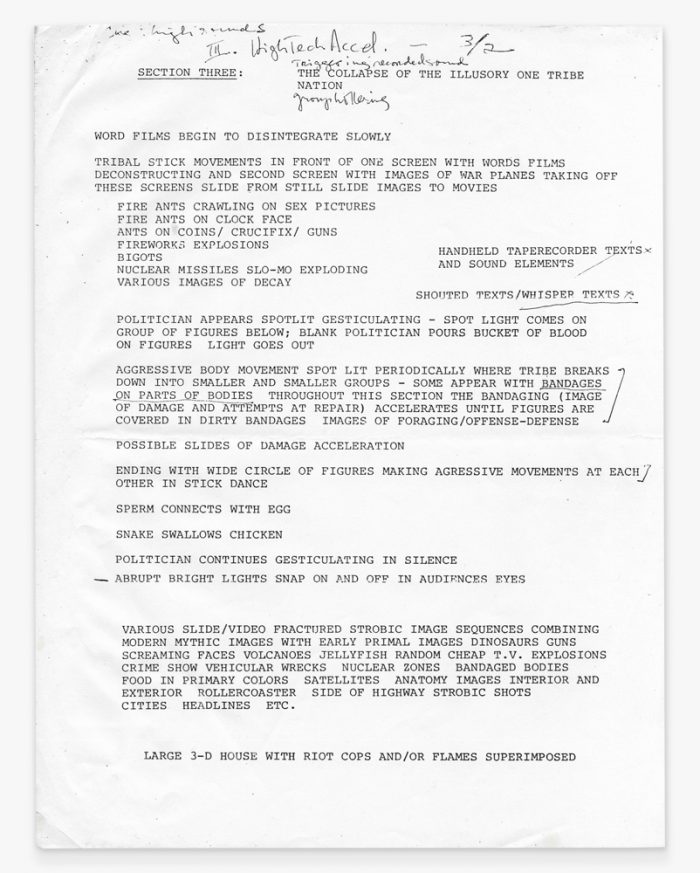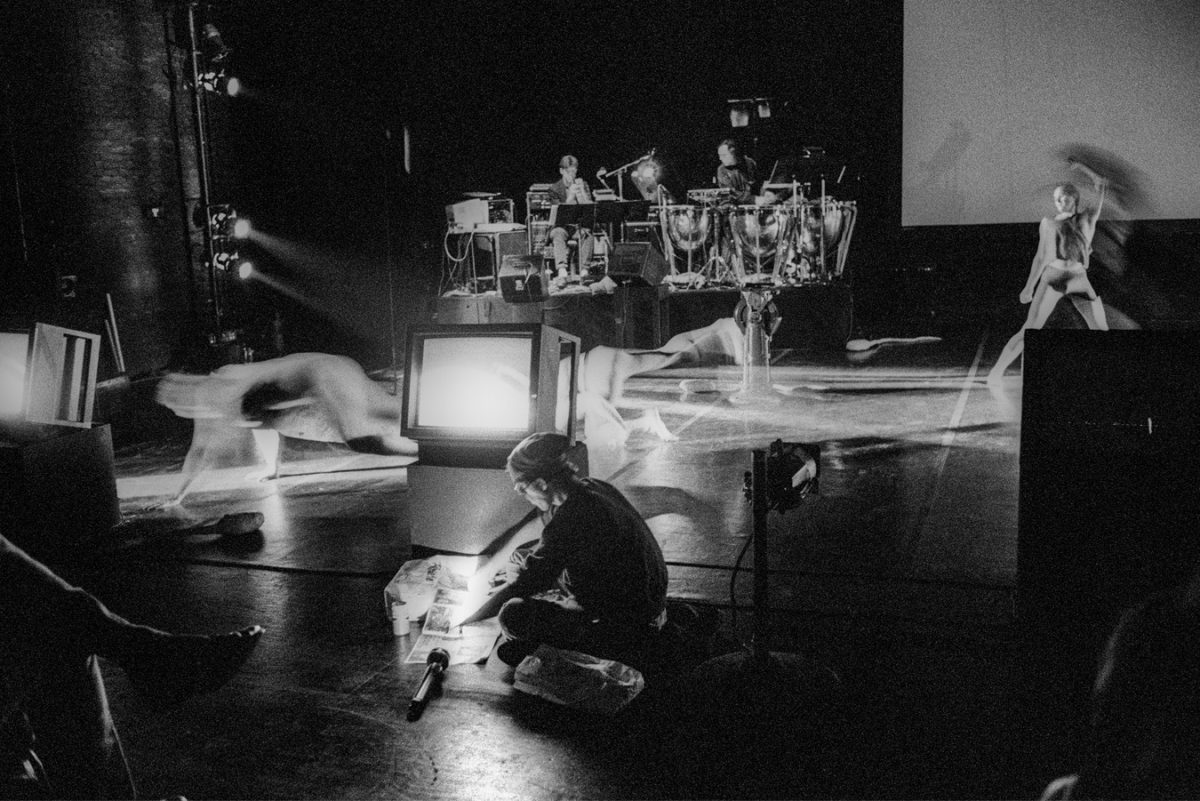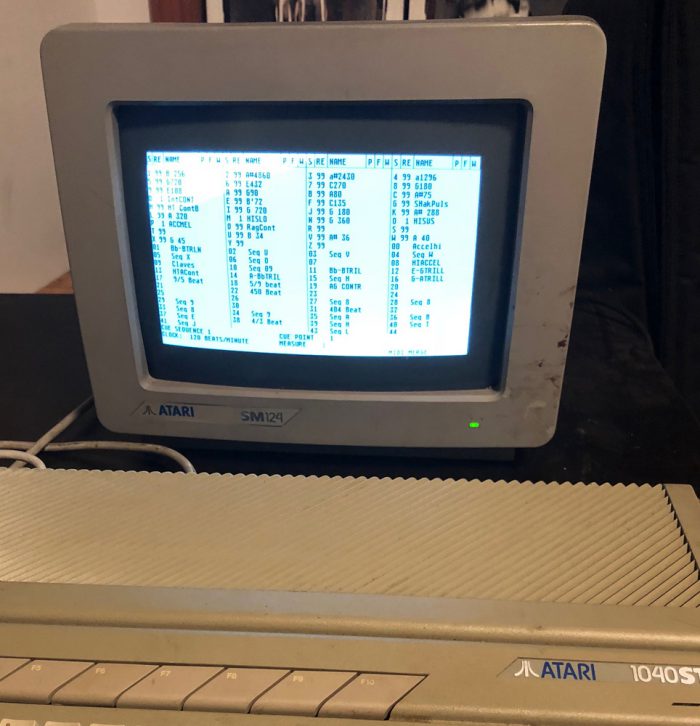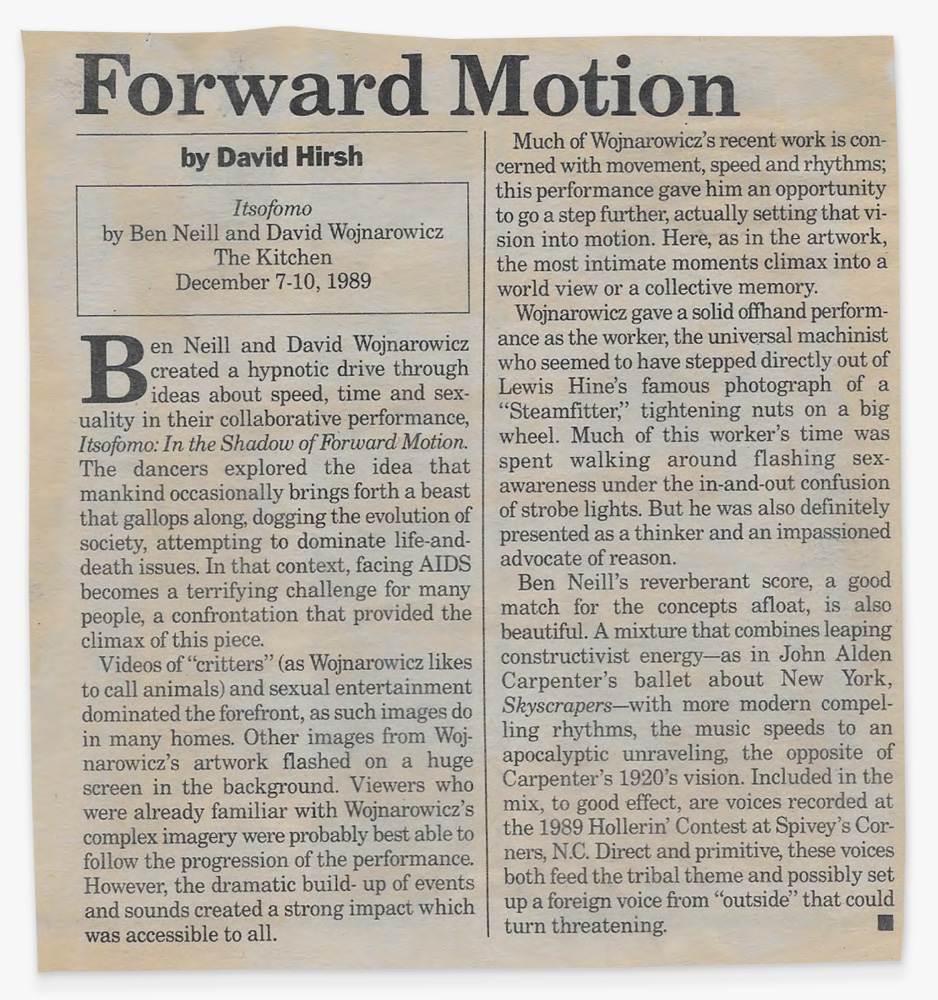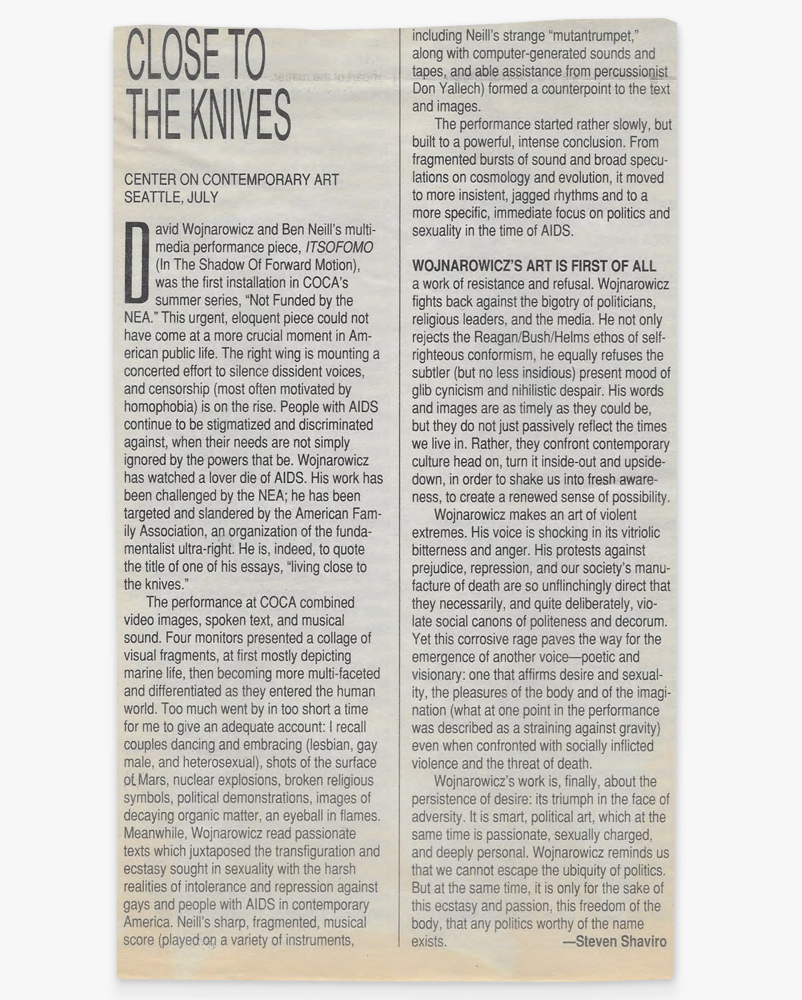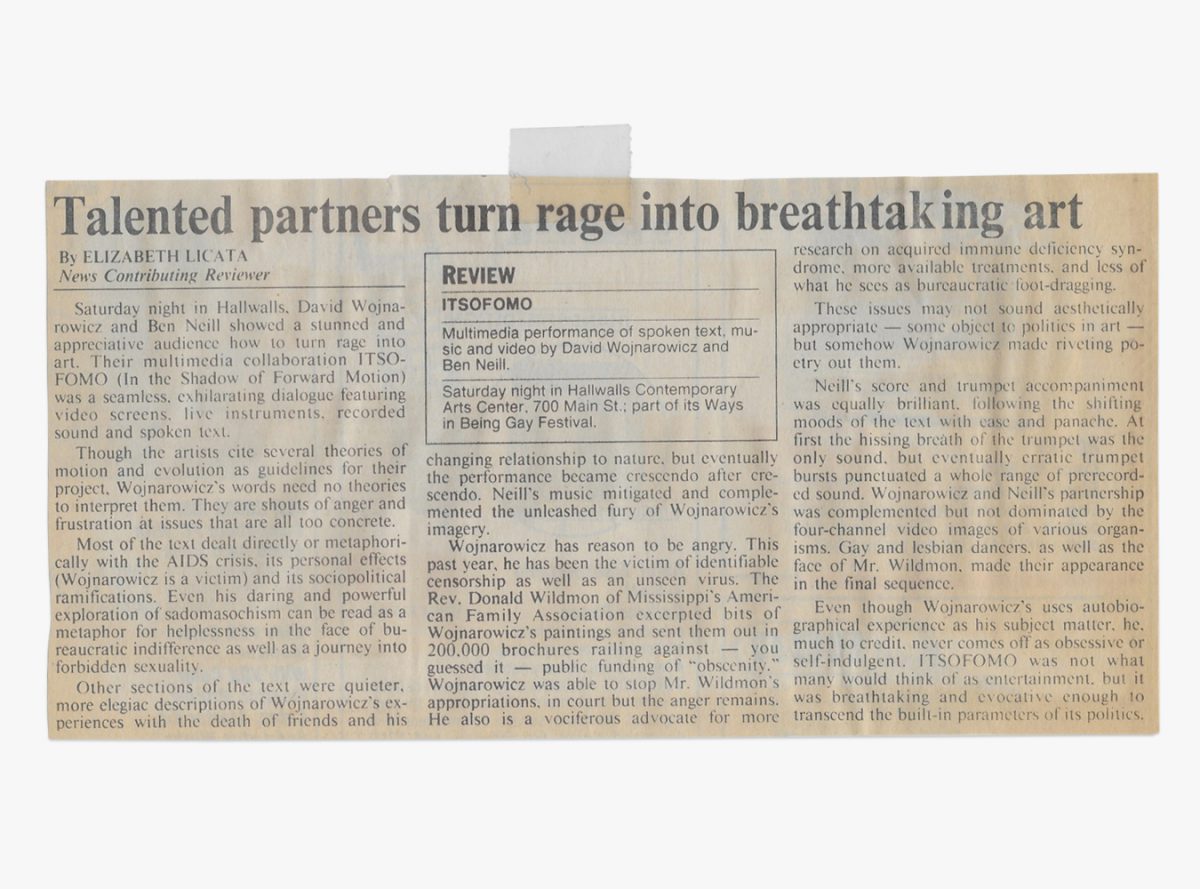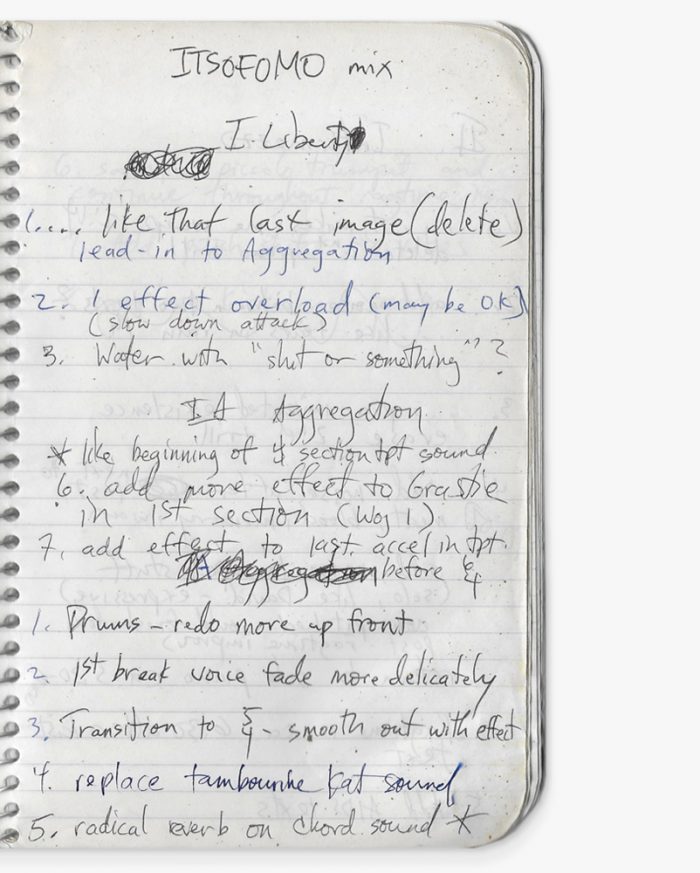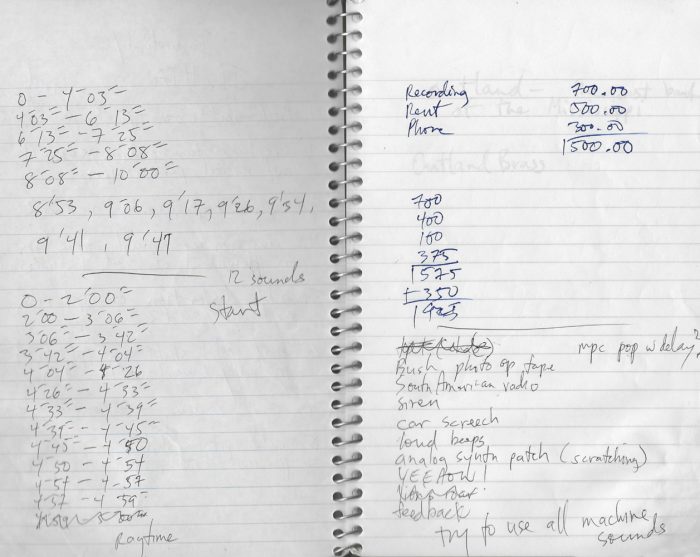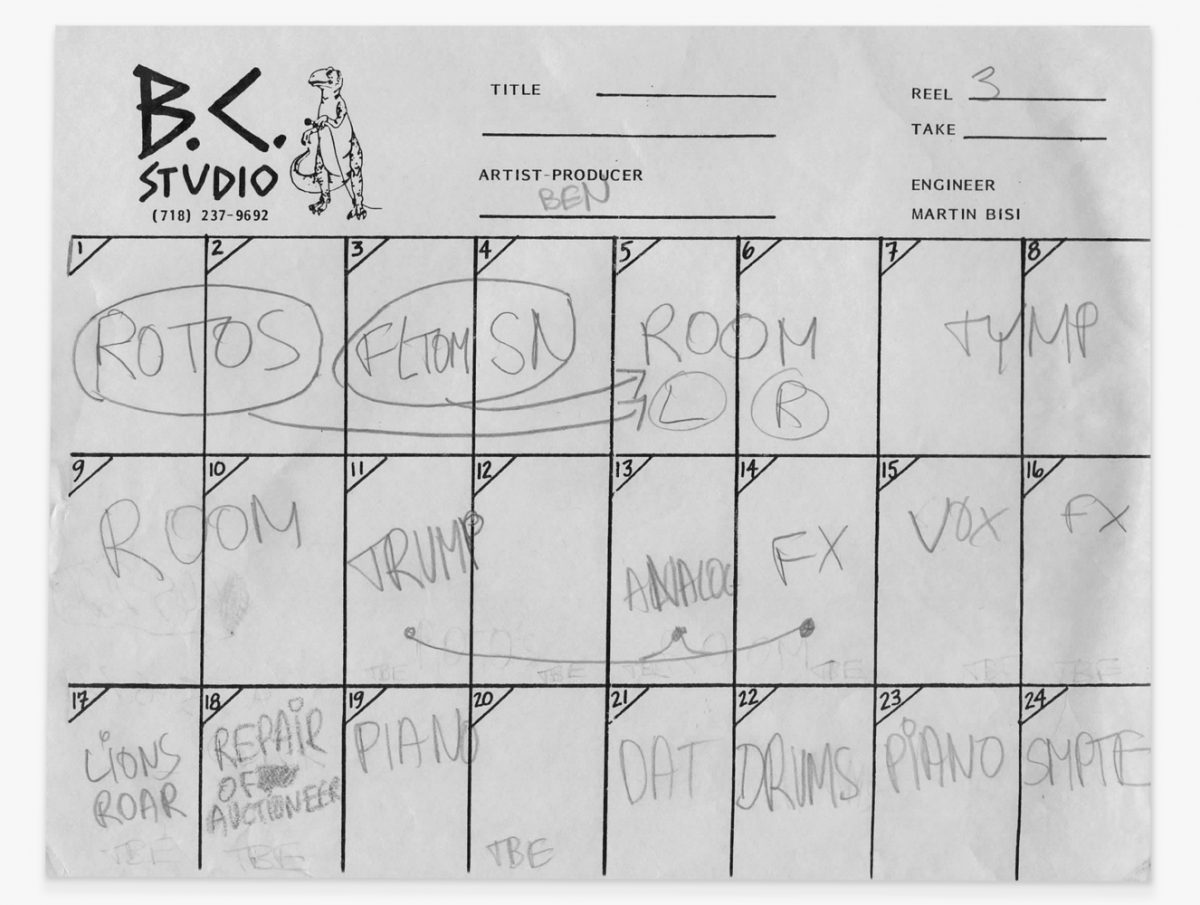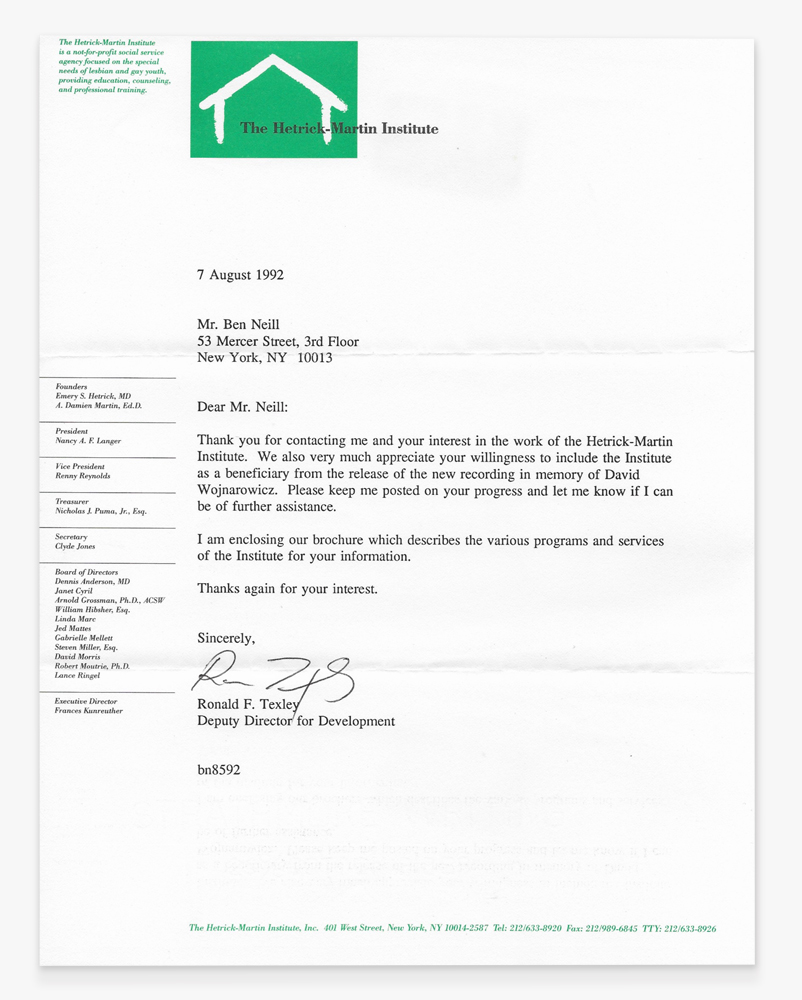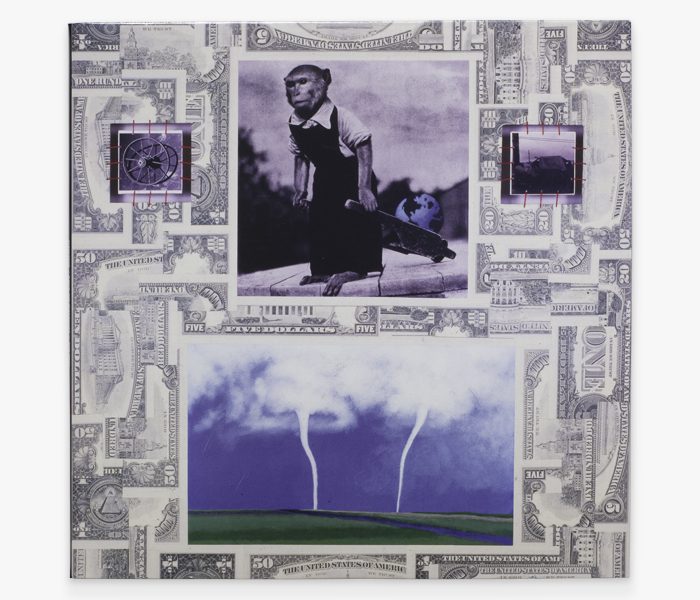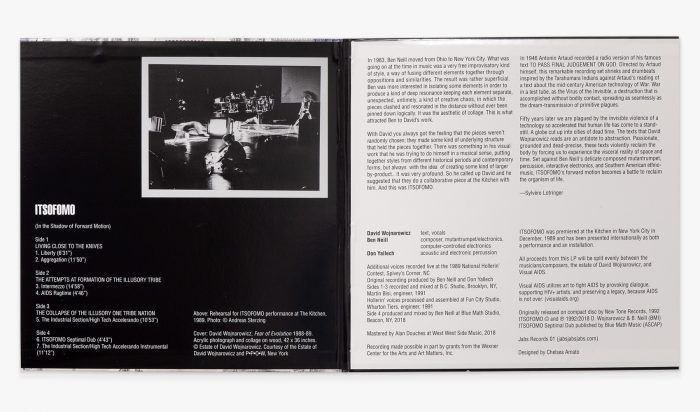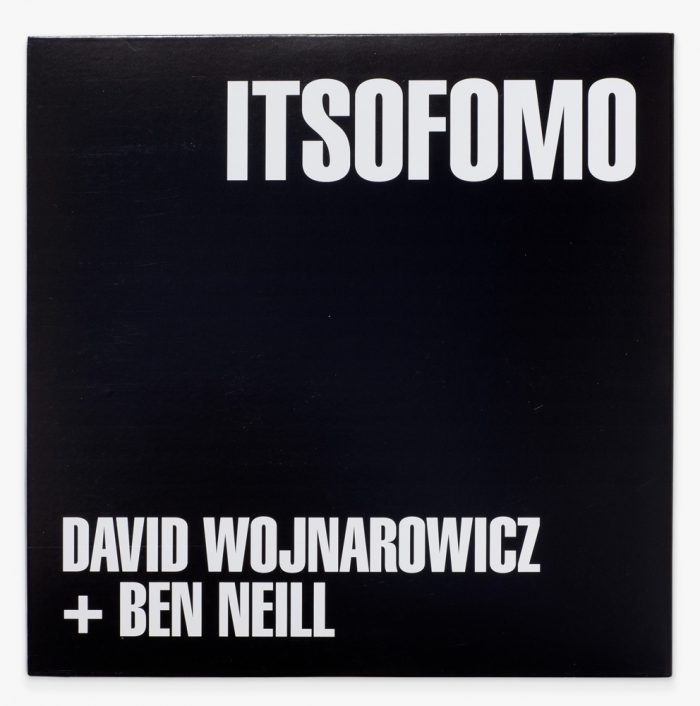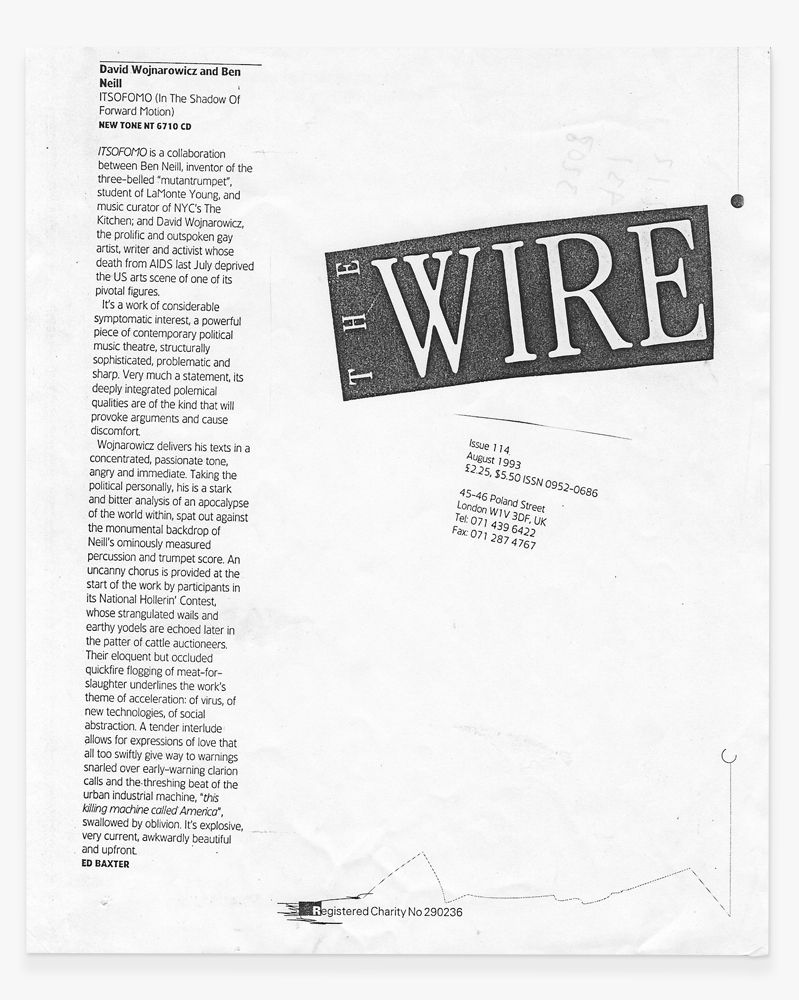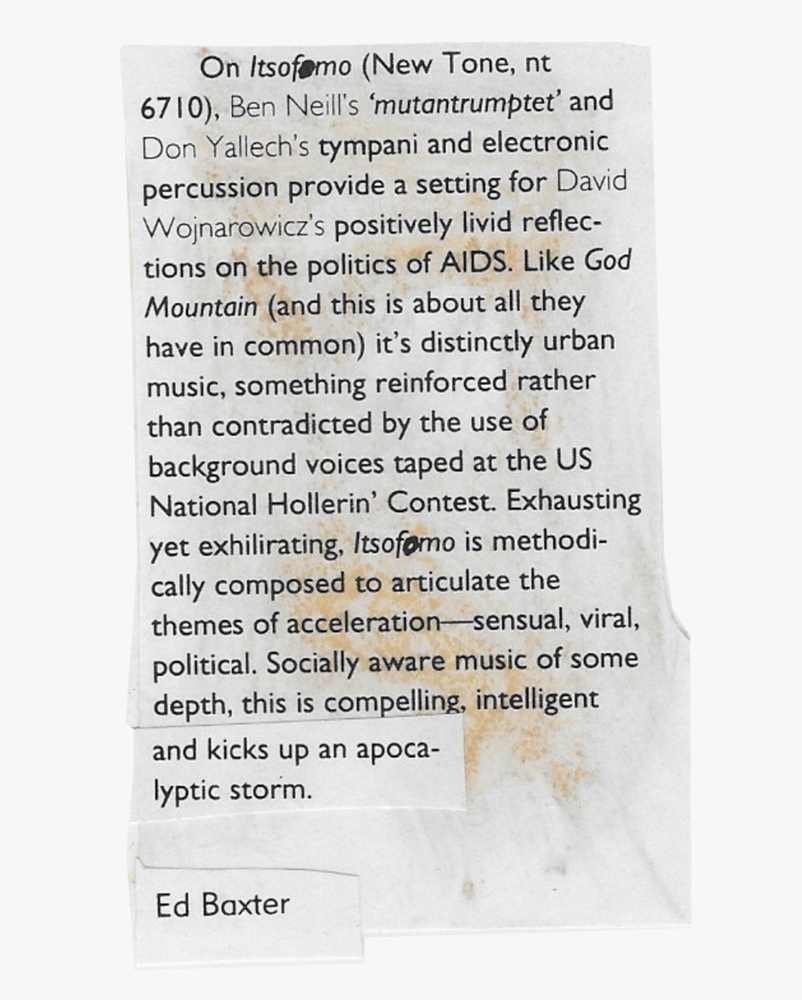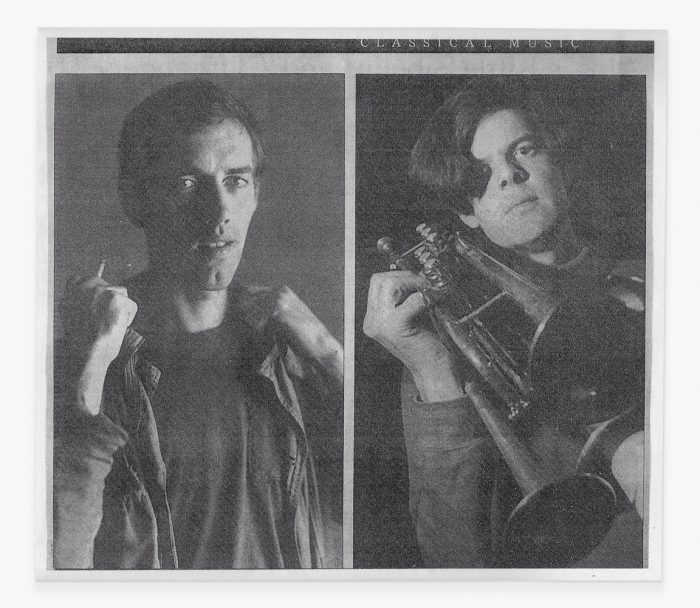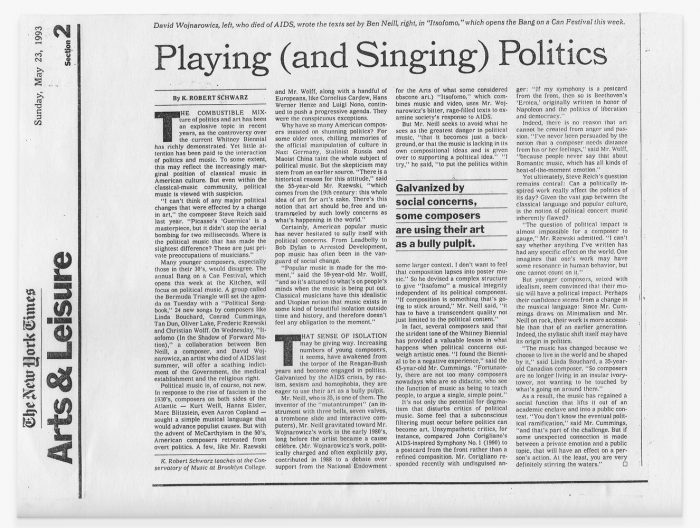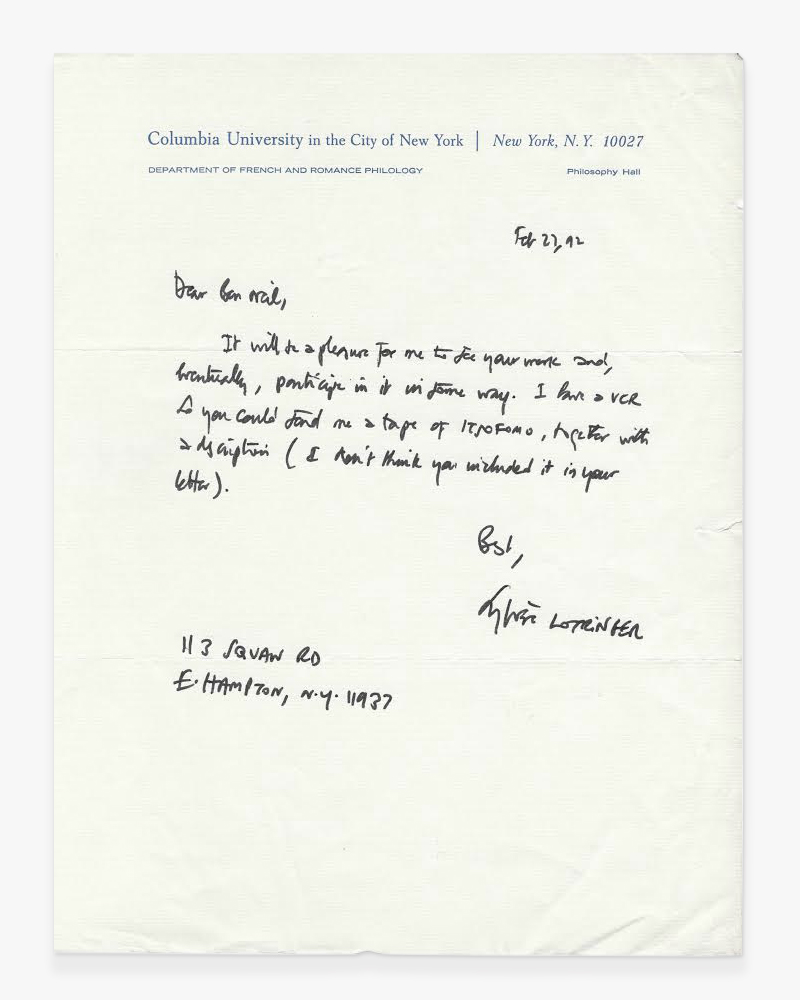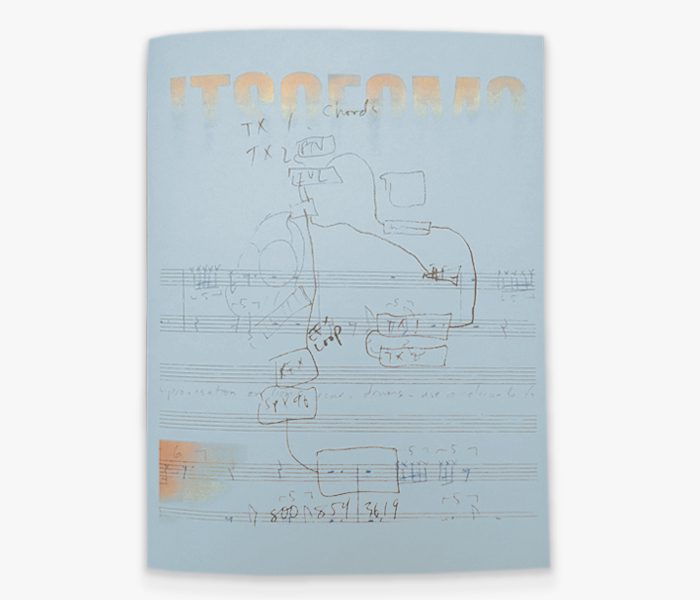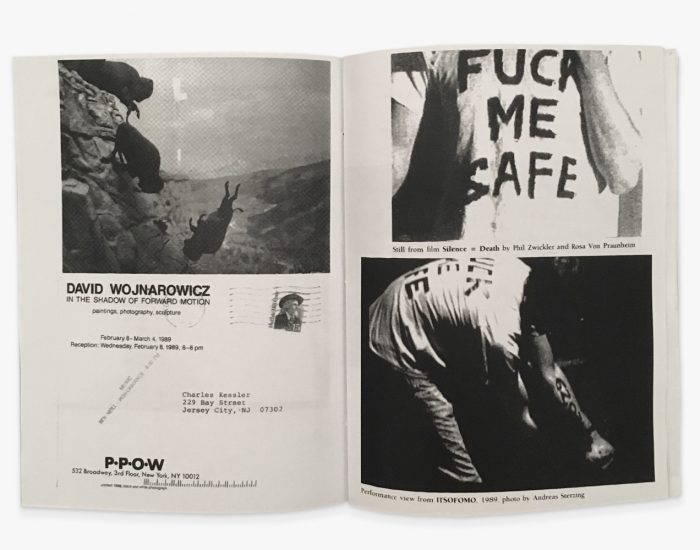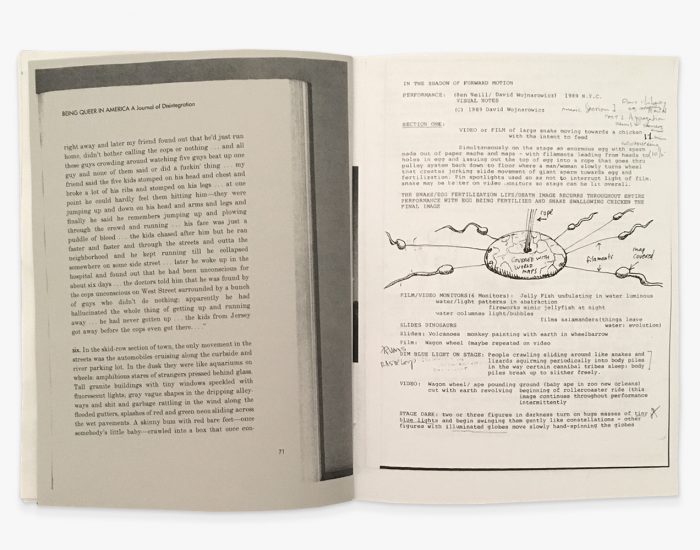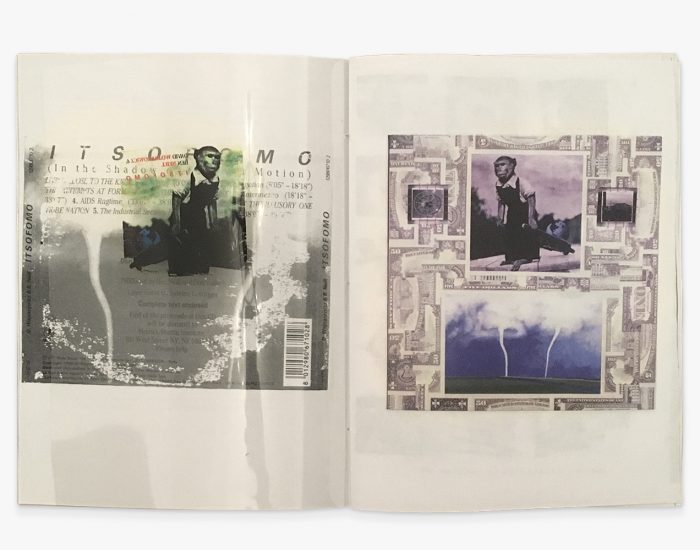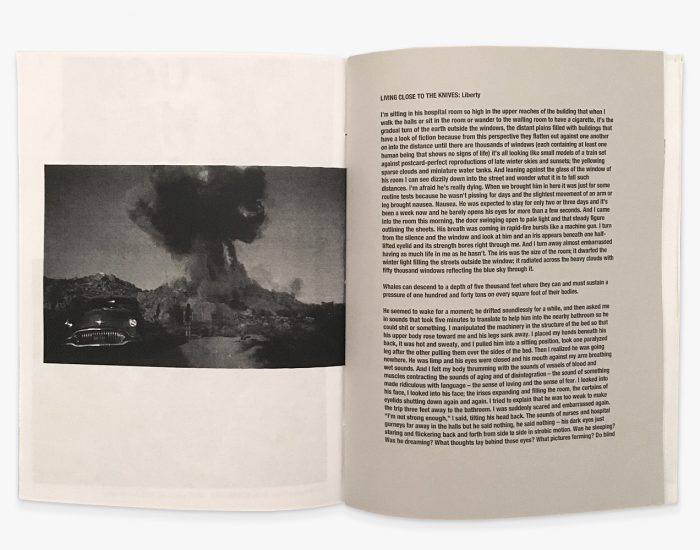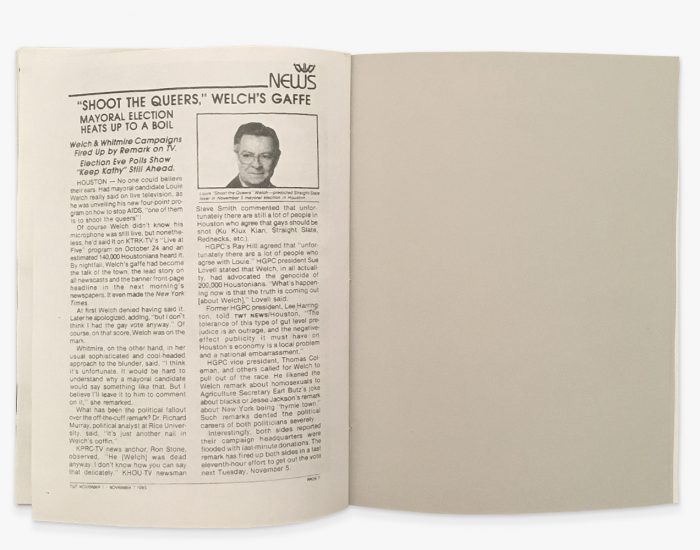
October 28 – December 17, 2018
ITSOFOMO (In the Shadow of Forward Motion) is a collaboration between the artist David Wojnarowicz and the musician Ben Neill. Composed of voice, mutantrumpet, electronics, and percussion, the piece offers an unnerving, hour-long deluge, described by The Wire magazine in 1993 as “explosive, very current, awkwardly beautiful and upfront.” Since its 1989 debut, ITSOFOMO has taken several forms – a performance, a video installation, an audio recording, and a screening. On the occasion of a new audio edition of ITSOFOMO, Know Wave reviews the history of this brilliant collaboration through original photographs, production notes, and correspondence drawn from the last 30 years. Through new interviews and archival texts, we unravel the ideas behind the piece, the labor that went into it, and the reactions it provoked.
This archival review is the first in a new online series produced by Know Wave. Key moments and figures in cultural history are reexamined through a cataloging of ephemeral materials and documentation, supported by new interviews with the participants. Amplifying the foundational considerations of Know Wave – discover, explore, experience – these rundowns will spotlight legendary scenes, critical records, and unexpected influences on music and art. Upcoming presentations include a deep dive into the tangled genius of writer, musician, filmmaker, and choreographer Brontez Purnell, and a reexamination of the volatile early years of devoted visionaries Black Dice.
ITSOFOMO (In the Shadow of Forward Motion) runs online Sunday, October 28 through December 17, 2018.
Ben Neill
P•P•O•W
The Estate of David Wojnarowicz
Sylvère Lotringer
Hedi el Kholti
Jennifer Doyle
Cynthia Carr
Martin Bisi
David Wojnarowicz (b. 1954, d. 1992) lived and worked in New York City as an artist and writer. Working across a broad range of media–including photography, painting, music, film, sculpture and writing–his art always illuminated the experiences of unseen people, starting with himself. Writing for the New York Times, Holland Cotter explained, “From the start, he took outsiderness itself, as defined by ethnicity, gender, economics and sexual orientation, as his true native turf.”
Fed by his early life experiences: an abusive childhood in suburban New Jersey, adolescent homelessness and sex work, coming to terms with his own queerness in a society that violently shunned it, Wojnarowicz worked to share these kinds of lives through his art. Part of his motivation was in retaliation against the “one tribe nation” – the forcefully maintained illusion of shared desires and family structures in the United States. But his greatest achievement was making “outsider” lives visible, to acknowledge individual existences and prevent them from being erased. Unsurprisingly, this project has faced fierce resistance throughout his life. In 1989, the National Endowment for the Arts revoked funding for an exhibition after seeing Wojnarowicz’s contributions. The obstruction has continued beyond the artist’s death from AIDS in 1992. In 2010, the Catholic League pressured the Smithsonian Museum into removing Wojnarowicz’s video, “Fire In My Belly,” from an exhibition, claiming the work was “designed to insult and inflict injury and assault the sensibilities of Christians.”
A recent retrospective of David Wojnarowicz’s work at the Whitney Museum demonstrates the continued relevance of his work, and the role that art can play in shaping human consciousness. “Like an irate guardian angel,” wrote Holland Cotter in 2018, “the American artist David Wojnarowicz was there when we needed him politically 30-plus years ago. Now we need him again.”
Ben Neill began designing the mutantrumpet in the early 1980s. Initially an acoustic instrument (a combination of three trumpets and a trombone), he worked with the synthesizer inventor Robert Moog to integrate electronics into the design. Neill studied composition with LaMonte Young, with whom he still works closely as a performer. He has released ten albums of his music, beginning with 1988’s Mainspring, and has collaborated with many musicians including Rhys Chatham, John Cale, DJ Spooky and Mimi Goese.
3 Teens Kill 4 was Doug Bressler, Brian Butterick, Julie Hair, Jesse Hultberg, and David Wojnarowicz. Formed in 1980, the band took their name from a New York Post headline. Their only release is the mini LP, No Motive.
“We were representative of our time and place. East village, New York City, 1980s. All-night, after-hour busboy jobs in trendy nightclubs, early morning breakfast at Veselka’s diner. Drugs and no-drugs. Gay and not-gay. New York.” – Jesse Hultberg in 2017, from the booklet included in the 2017 reissue of No Motive by Dark Entries.
3 Teens Kill 4, No Motive LP (Originally issued by Point Blank Records, 1983, reissued by Dark Entries, 2017).
$20
Sold Out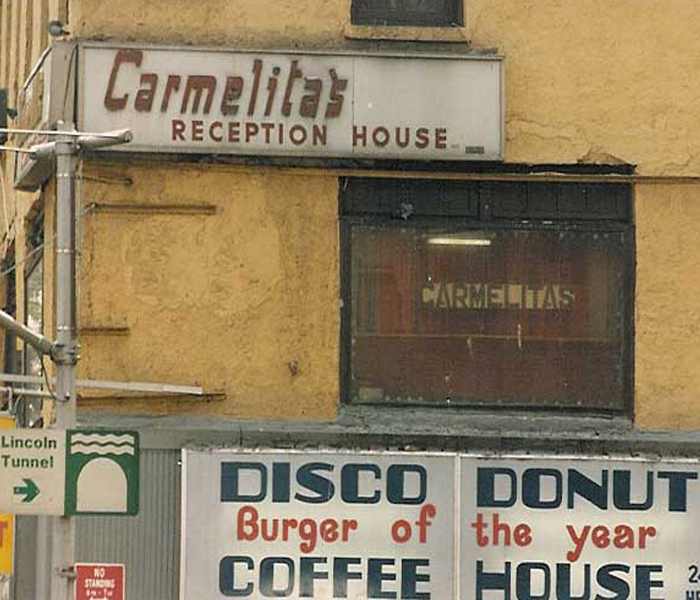
“David was now occasionally meeting Ben Neill for coffee at Disco Donut on Fourteenth Street. They discussed the book Pure War, a conversation between French thinkers Paul Virilio and Sylvère Lotringer… They talked about collaborating and sealed it when Neill was offered a slot to perform at the Kitchen in late ’89.” – from Fire in the Belly: The Life and Times of David Wojnarowicz, by Cynthia Carr, published 2012 by Bloomsbury USA.
“I needed some artwork for the album cover. There were two pieces of [David’s] that I really liked, and I asked him if he would do the cover using some of those elements… One of them was a blue piece, mostly sky, called ‘The Anatomy and Architecture of June 19, 1953,’ about Julius and Ethel Rosenberg. And the other one had a figure sleeping in the foreground with maps covering it, ‘History Keeps Me Awake at Night.’ Anyway, he ended up making a piece that incorporated those elements titled, ‘Some Things From Sleep II.’ I was very ecstatic about the whole thing. So that was how we originally met.” – Ben Neill in an interview with Sylvère Lotringer, from David Wojnarowicz: A definitive history of five or six years on the lower east side, edited by Giancarlo Ambrosino, published 2006 by Semiotext(e)
“We started it off from a kind of abstract formal concept: the idea of acceleration. ITSOFOMO is an abbreviation for In The Shadow of Forward Motion, a title David had used for one of his earlier pieces. ITSOFOMO is structured so that there’s acceleration happening on all these different micro- and macro-levels. You get things both magnified and very reduced.” – Ben Neill in an interview with Sylvère Lotringer, from David Wojnarowicz: A definitive history of five or six years on the lower east side, edited by Giancarlo Ambrosino, published 2006 by Semiotext(e).
“I didn’t want people to just think that, we were up there making a bunch of noise, and it was purely an outpouring of anger or something. Frankly a lot of that content, the political stuff, was the very last layer. I didn’t really even know exactly what [David] was going to do until we got into the final rehearsals before we premiered it. So much of the work on the structure wasn’t really about that, it was more about pacing and timing and how the whole thing was going to feel.” – Ben Neill in a 2018 interview with Know Wave.
“This edition presents the audio of the ‘Cross Country’ tapes in published form for the first time. Other than minor edits for length, the audio in this edition is just as Wojnaorwicz recorded it. In addition to having been deliberate about his intention to have his private journals posthumously published, Wojnarowicz was clear about the political implications of the very idea of the private-public divide. ‘Each public disclosure of a fragment of private reality serves as a dismantling tool against the illusion of a ONE-TRIBE NATION.” – Derek Baron of Reading Group, in the liner notes of David Wojnarowicz, Cross Country 3xLP.
“I’m also doing a painting that’s four feet by five feet, that’s completely covered with money–printed money from a joke store. I like to use things that are preprinted or printed by industrial means for mass consumption. What I’m doing with the money is cutting holes in it and putting photographs inside the holes that will reflect a new design for money, or what money is actually used for: either consumption, control, or whatever.” – David Wojnarowicz in a January 1989 tape journal, from Weight of the Earth: The Tape Journals of David Wojnarowicz, edited by Lisa Darms and David O’Neill, published 2018 by Semiotext(e).
Fear of Evolution Know Wave T
100% cotton t-shirt, full color print plus screenprint. The shirt features David Wojnarowicz’s work Fear of Evolution, 1988-89. Acrylic photograph and collage on wood, 42 x 36 inches. © Estate of David Wojnarowicz. Courtesy of the Estate of David Wojnarowicz and P•P•O•W, New York.
$40
Sold Out“I’m from Winston-Salem, North Carolina, Spivey’s Corner was further down toward Raleigh and the eastern part of North Carolina. The Hollerin’ Contest is the one time a year that these people get to show off their stuff. I rented a DAT machine and a couple of condenser mics and recorded the whole thing, I went there to record the hollerin’ with this piece in mind. For the people I thought were really distinctive, I went up to them and asked them to record individually. I had them come back behind the stage, which was a flatbed truck in the middle of a football field. I remember the one guy brought his dog up on stage with him.” – Ben Neill in a 2018 interview with Know Wave.
“That’s my diagram of the whole set up. Don played an electronic drum pad and then there were triggers on the acoustic drums, piezo discs on the timpani. When he would strike or roll on the drums, he had a foot petal where he could control the send of the sound into the drum pad. So when he plays it could go into this lexicon effect, where the sound is bending up, and that was another way of expressing acceleration through increasing frequency. David had a pedal like that, all the effects that were added onto his voice was his choice, he controlled that, in performance and on the recording.” – Ben Neill in a 2018 interview with Know Wave.
“I made this timeline as the piece came together, more for myself, we didn’t actually play off of this. The Liberty section ended up being more free than what’s written here. Originally I had put all of the fragments, I cut and pasted them as little pieces of white paper and the idea was just to jump around, like the Stockhausen or Earl Brown pieces where you jump around. Eventually as we got to know it better we were able to just improvise it. The voice cues, and the aggregation section is all written out, that’s all scored out. And then the last section is all scored out for Don but not for me, I play the same notes and kind of the same gestures but where I play it is left up to improvisation.” – Ben Neill in a 2018 interview with Know Wave.
“It was highly structured, all the durations of the notes. Writing it down, it almost like a puzzle or something, I had these different parameters I was working with in terms of those frequency structures and the ratios and all. Some of it just came out of playing: I want it to sound like this. Other things, the long notes in the Aggregation for example, those are all very much timed out. It was the kind of thing, I couldn’t have conceptualized it, it’s not like writing music where you sit down at the piano: oh here’s a melody, I like this. There was a little bit of that, but so much of it was structured. Almost a Cage-ian, non structured process going on. So the realization of that, when you put it down on paper, that’s when it becomes something.” – Ben Neill in a 2018 interview with Know Wave.
“That was essentially the closest thing there was to a script for the performances at The Kitchen. Fales Library has a clean version of this document, but I think the writing here is all the choreographer, Gloria McLean, because it’s all notes pertaining to the dancers.” – Ben Neill in a 2018 interview with Know Wave.
Originally from Ohio, percussionist Don Yallech moved to New York to study at the Manhattan School of Music. In addition to his ongoing musical collaboration with Ben Neill, Yallech has collaborated with Rhys Chatham, Joey Ramone, and the New Music Consort. He has been a member of the bands Feed and The Psychedelic Furs, and has performed with John Cage, the Armitage Ballet and numerous touring Broadway shows.
“In the Shadow of Forward Motion. The meaning of that title is: Consider that you’re in a car and you’re speeding along an expressway, and everything you see out of the corner of your eye that doesn’t register in the pursuit of that speed, in terms of motion, is what’s in the shadow. It’s all the things quietly occurring within the absence of sight that take place in the pursuit of speed, in terms of motion.” – David Wojnarowicz in a February 1989 tape journal, from Weight of the Earth: The Tape Journals of David Wojnarowicz, edited by Lisa Darms and David O’Neill, published 2018 by Semiotext(e).
“I was working out of my apartment. I was living in downtown Brooklyn for most of this, on Willoughby Street, I had a loft there. When I first met David, I still lived in the East Village, but by the time we started working on this piece I’m pretty sure I had moved. I didn’t have a studio in the sense that I could record anything, at that point the live setup and the studio were the same thing. Now I have the studio computer where I would make recordings and my little live rig set up separately, but back then it was just one thing all based around this Atari 1040ST computer and hardware synthesizer.
“The Atari 1040ST was purely a MIDI controller, so all the sounds came from hardware synthesizers. It took floppy discs, and you had to boot up the whole thing every time you turned it on. Put the disc in with the program. It was very popular with musicians because it had a built-in MIDI interface which was a big deal back then. I think it was probably the only computer that had a built-in MIDI interface.” – Ben Neill in a 2018 interview with Know Wave.
“Artist, writer, activist. For David Wojnarowicz, these three identites were of a single piece—an extension of his wised-up, earnest, angry self. He perfected this point of view privately, in diaries, sketches, and notes. In March 1981, he discovered a new method: the audio journal. He spoke into a tape recorder—though he felt terribly self-conscious doing so—after he had just woken up, as he stewed in his apartment, or while on long, solitary road trips.” – Lisa Darms and David O’Neill in the Editors’ Introduction to Weight of the Earth: The Tape Journals of David Wojnarowicz. Edited by Lisa Darms and David O’Neill and published 2018 by Semiotext(e).
Weight of the Earth: The Tape Journals of David Wojnarowicz. Edited by Lisa Darms and David O’Neill and published 2018 by Semiotext(e).
$16
Sold Out“Anyway, the way the train went into the American West and blew open or exploded Indian culture, that’s the same way that I see telecommunications today–the way the authorities have used telecommunications. There’s no longer real culture. I can turn on the TV and find myself six thousand miles under the ocean; or turn a station and then suddenly I’m in China, walking the Great Wall; or turn the station and suddenly I’m in the Amazon, watching a rainforest get cut down. The way telecommunications has blown through the cultures of different countries, I believe it’s like we’re on a fast train that becomes a faster train, that becomes a plane, that becomes a missile. Which means, in terms of speed, that eventually we won’t have to go anywhere at all because everything’s the same. It becomes the same after a while, and there will be no need for movement.” – David Wojnarowicz in a January 1989 tape journal, from Weight of the Earth: The Tape Journals of David Wojnarowicz, edited by Lisa Darms and David O’Neill, published 2018 by Semiotext(e).
“It was very ambitious in terms of the amount of stuff that we were doing live. The whole piano section I was triggering little extra sequences from the computer keyboard. Not a piano keyboard, but I was pressing keys on the computer keyboard and triggering different switches and at the end I would accelerate the tempo manually, I had a key command where I would push it all the way up to 999 beats per minute so it would reach this statis.” – Ben Neill in a 2018 interview with Know Wave.
“Right after my diagnosis, the things I appreciated for a period of time, about people who were dying from AIDS, was how courageous they were all the way up to the end, and all the words that connect to courage in people’s minds for those who are facing death. I thought Peter [Hujar] was courageous, and even in the midst of his rage he was courageous. Every time I experienced a friend’s death, or knew of a friend’s death, or a friend’s illness and experienced part of it, I thought it was with great courage that they were living.
“Once I was diagnosed, the idea of courage enraged me. I thought this is bullshit really, they’re talking about politeness, that the more politely a person dies, the more courageous they are, that they should contain the experience of their death within themselves and make it very easy for everybody so that they slip through, die and that’s it. And everybody can live with it, rather than confront themselves with death, with rage, with all the expressions that somebody who’s not being polite exhibits.” – David Wojnarowicz in a 1989 interview with Sylvère Lotringer, from David Wojnarowicz: A definitive history of five or six years on the lower east side, edited by Giancarlo Ambrosino, published 2006 by Semiotext(e).
“I think [George] Bush’s voice is in the piece a couple of times. It might’ve been something that David had recorded and distorted or manipulated. We collected a lot of sound effects, those are the sounds that start coming in near the end of the Intermezzo before the Ragtime. Some of them were cassettes that David had, and there were some sound effect CDs and LPs. We just made a kind of collage on the 24 track. When we would play it live, we would run a DAT tape of the hollerin’ voices and these sound effects were on the same tape. – Ben Neill in a 2018 interview with Know Wave.
“David was very weak at that point and we didn’t want to stress him out. It was just great to get him to do it one time, I remember feeling that. We did it beginning to end, we recorded it as a performance. We did have to take breaks because we had to change the reels. You couldn’t record that much onto one reel of 24 track tape. But it was important that we recorded live, all at the same time. It wasn’t like the way I was recording my other pieces at that time, where we laid down the percussion and then the trumpet track by track. With all the improvised stuff and the energy between us [on ITSOFOMO] I would have never thought about doing it separately.” – Ben Neill in a 2018 interview with Know Wave.
“In the wake of David Wojnarowicz’s death, critic and cultural theorist Sylvère Lotringer undertook to track down all of Wojnarowicz’s friends and former collaborators. Lotringer wanted to talk not just about David, but about the East Village cultural scene they’d created.” – from the jacket of David Wojnarowicz: A definitive history of five or six years on the lower east side, interviews by Sylvère Lotringer, Edited by Giancarlo Ambrosino. Published 2006 by Semiotext(e).
David Wojnarowicz: A definitive history of five or six years on the lower east side, interviews by Sylvère Lotringer, Edited by Giancarlo Ambrosino. Published 2006 by Semiotext(e).
$30
Sold Out“In 1979, life partners and educators on gay and lesbian issues, Dr. Emery Hetrick, a psychiatrist, and Dr. Damien Martin, a professor at New York University, heard the heartbreaking story of a homeless 15-year-old boy who had been beaten and thrown out of his emergency shelter because he was gay. They were so moved that they gathered a group of concerned adults and created what was then called the Institute for the Protection of Lesbian and Gay Youth (IPLGY) to assist this group of young people who desperately needed support. In 1988, the organization was renamed Hetrick-Martin Institute in honor of its founders and their lifelong commitment to service.” – from the website of the Hetrick-Martin Institute.
“The decision to donate proceeds from the CD to Hetrick-Martin, that was totally David. I remember he knew immediately, he really wanted that. There was no doubt that that’s what it would be.” – Ben Neill in a 2018 interview with Know Wave.
“I was really frustrated, because I had a really hard time finding anybody to put that tape out. I held it for over a year, trying to get someone to distribute it. It’s a controversial, very heavy piece.” – Ben Neill in an interview with Sylvère Lotringer, from David Wojnarowicz: A definitive history of five or six years on the lower east side, edited by Giancarlo Ambrosino, published 2006 by Semiotext(e).
Originally released on CD by New Tone records in 1992, this is the first vinyl pressing of ITSOFOMO. The 2xLP includes two previously unreleased tracks: an instrumental version of the climactic movement “THE COLLAPSE OF THE ILLUSORY ONE TRIBE NATION” and a new remix by Ben Neill, “ITSOFOMO Septimal Dub.” Printed in an edition of 500 copies with a gatefold sleeve and an essay by Sylvère Lotringer. A portion of the proceeds from this LP will be donated to Visual AIDS.
David Wojnarowicz + Ben Neill, ITSOFOMO 2xLP. (Originally issued on CD by New Tone, 1992, vinyl edition issued by Jabs, 2018).
$35
Sold Out“and wanting a shout to come from my throat, a shout that would level all the buildings or else have the strength in my hands where I could rip open the earth like a cheap fabric and release a windscreen of lava and heat or with the fists banging against my thighs create shockwaves that would cause all the manufacturing of the preinvented world to come tumbling down in a slow and terrifying beauty till all the earth was level or maybe or maybe or maybe just to have some water pour from my head.” – David Wojnarowicz,”LIVING CLOSE TO THE KNIVES: Liberty” lyrics (excerpt) from ITSOFOMO.
“A year after the big earthquake the buildings are still tumbling, great heaving cracks their facades, thirty floors of vacant offices, burst windows, potted plastic palms and calendars flapping above dead machines.” – David Wojnarowicz, “LIVING CLOSE TO THE KNIVES: Aggregation” lyrics (excerpt) from ITSOFOMO
“When I put my hands on your body on your flesh I feel the history of that body. Not just the beginning of its forming in that distant lake but all the way beyond its ending. I feel the warmth and texture and simultaneously I and simultaneously and simultaneously I see the flesh unwrap from the layers of fat and disappear. I see the fat disappear from the muscle. I see the muscle dis- disappear from around the organs and detaching itself from the bones. I see the organs gradually fade into transparency leaving a gleaming skeleton gleaming like ivory that slowly resolves until it becomes dust. I am consumed in the sense of your weight the way your flesh occupies momentary space the fullness of it beneath my palms. I am amazed at how perfectly your body fits to the curves of my hands. If I could attach our blood vessels so we could become each other I would. If I could attach our blood vessels in order to anchor you to the earth to this present time to me I would. If I could open up your body and slip inside your skin and look out your eyes and forever have my lips fused with yours I would. It makes me weep to feel the history of you, of your flesh beneath my hands in a time of so much loss. It makes me weep, it makes me weep to feel the movement of your flesh beneath my palms as you twist and turn over to one side to create a series of gestures to reach up around my neck to draw me nearer. All these moments will be lost in time like tears in the rain.” – David Wojnarowicz, “THE ATTEMPTS AT FORMATION OF THE ILLUSORY TRIBE: Intermezzo” lyrics (excerpt) from ITSOFOMO.
“‘If I had a dollar to spend for health care I’d rather spend it on a baby or innocent person with some defect or illness not of their own responsibility; not some person with AIDS’ says the health-care official on national television and this is in the middle of an hour-long program of people dying on camera because they can’t even afford the limited drugs available that might extend their lives and I can’t even remember what this official looked like because I reached in through the tv screen and ripped his face in half.” – David Wojnarowicz, “THE COLLAPSE OF THE ILLUSORY ONE TRIBE NATION: The Industrial Section/High Tech Accelerando” lyrics (excerpt) from ITSOFOMO.
“The Bang on A Can festival was the first performance we did of ITSOFOMO after David’s death, Don and I, just the two of us.” – Ben Neill in a 2018 interview with Know Wave.
“I’ve been asked to perform it in a number of different places since David died, and I had mixed feelings about doing it. I didn’t want it to be like a funeral… It’s really sad to hear his voice on tape.” – Ben Neill in an interview with Sylvère Lotringer, from David Wojnarowicz: A definitive history of five or six years on the lower east side, edited by Giancarlo Ambrosino, published 2006 by Semiotext(e)
“The texts that David Wojnarowicz reads are an antidote to abstraction. Passionate, grounded and dead-precise, these tests violently reclaim the body by forcing us to experience the visceral reality of space and time. Set against Ben Neill’s delicate composted mutantrumpet, percussion, interactive electronics, and Southern American ethno-music, ITSOFOMO’s forward motion becomes a battle to reclaim the organism of life.” – Sylvère Lotringer in the liner notes to ITSOFOMO, 1992/2018.
ITSOFOMO zine
Black and white and color photocopy, 36 pages, 8 inches x 6 inches. Sewn binding.
Open edition, only available for purchase between October 28 – December 1, 2018.
$15
Sold Out